#love an evil pietà
Text

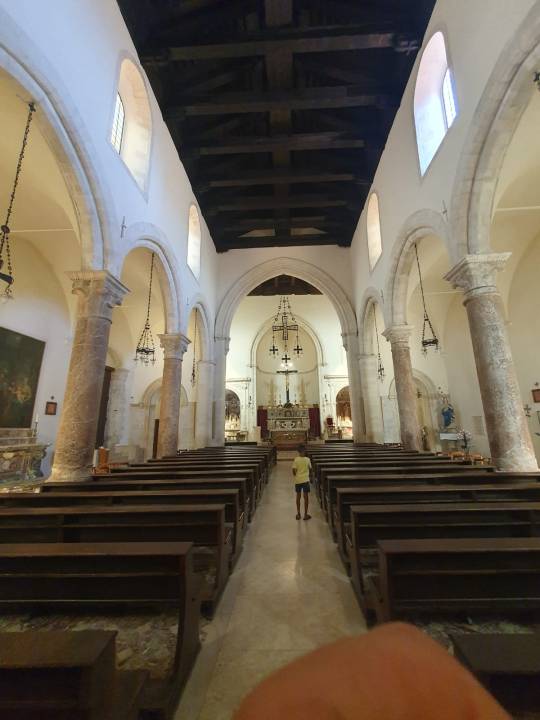




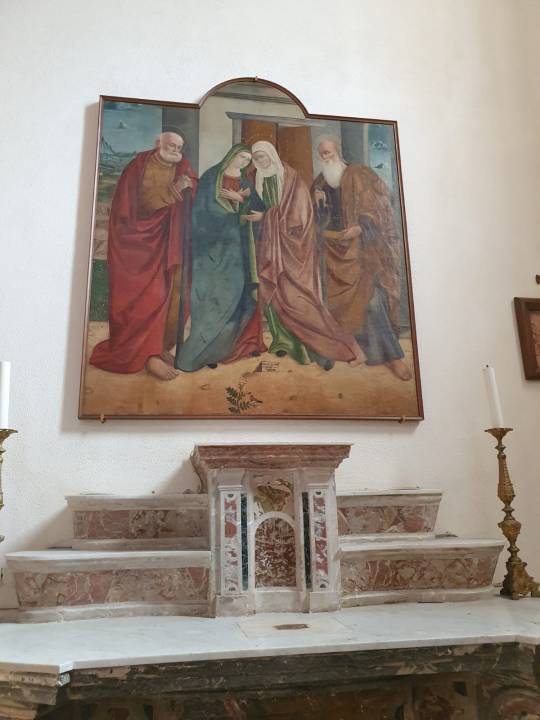



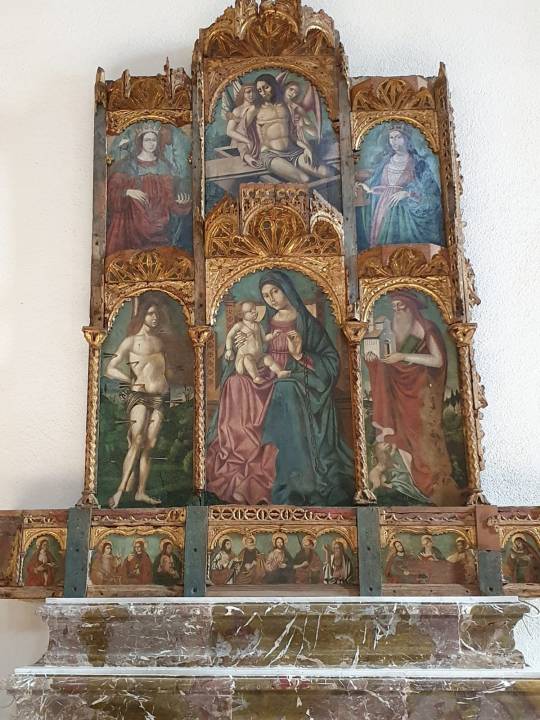



Duomo di Taormina
Lascia stare quello che dicono i libri. Non ti serve leggere quando questo piccolo duomo è stato costruito per capire cosa è. Di sicuro, migliaia di anni fa, c’era già li un luogo dedicato a un Dio perché il Duomo è messo di fronte all’infinito, dove il cielo finisce, dove inizia il mare e dal mare nasce, ripido e fiero, il promontorio su cui il Duomo si trova. È un posto dove le anime sentono l’eternità e vorrebbero spiccare il volo per comprendere l’esistenza. Proprio qui, in questo luogo che ci pone di fronte alle domande di cui cerchiamo risposte si trova questa chiesa, proprio qui, di fronte al paradiso, sotto gli occhi di Dio. Non guardare i quadri esposti sopra i suoi altari come se fossero opere d’arte, anche se antichi e preziosi. Sono in realtà le orecchie di Dio, ascoltano le preghiere di chi non può non chiedere, ascoltano i dolori, le speranze, quei peccati nati dal bisogno di cose o da quel bisogno di amore che ci infetta con un male chiamato solitudine. Anche i preziosi marmi degli altari, non sono grandi per mostrare la magnificenza delle pietre siciliane. Sono solo inginocchiatoi, fatti per chi cercava pietà. Ora non vedi le vecchie vestite di nero, pregare i loro santi, perché ormai basta trovare conforto in sentimenti minori, in illusioni scientifiche o sciamaniche, dentro la continua distrazione di Reel e post, nel consumo continuo di cose ed emozioni. Ma questo era ed è il Duomo, la casa delle anime a cui manca la pace. Delle anime che non sanno trovare nessuna pace, spaventate, confuse dalle guerre piccole o grandi, vicine o lontane, dalle stragi straordinarie o dai quotidiani genocidi, anime che cercano motivi, spiegazioni, speranze o certezze per non sentirsi inutili, calpestaste, ignorate, dimenticate. Non guardare il Duomo come se fosse una pietra più o meno antica, un dipinto di secoli fa, una scultura che gli antichi romani hanno lasciato. Consideralo un giardino in cui le anime possano provare respiro, percepire il loro tempo, concepire e cercare l’armonia che hanno perduto, tornare pure, in questo piccolo altare posto di fronte al Paradiso, sotto gli occhi di Dio.
Forget what the books say. You don't need to read when this little dome was built to understand what it is. Certainly, thousands of years ago, there was already a place dedicated to a God because the Cathedral faces infinity, where the sky ends, where the sea begins and from the sea rises, steep and proud, the promontory on which the Cathedral is located. It is a place where souls feel eternity and would like to take flight to understand existence. Right here, in this place that confronts us with the questions to which we seek answers, lies this church, right here, in front of paradise, under the eyes of God. Do not look at the paintings displayed above its altars as if they were works of art, even if ancient and precious. They are in reality the ears of God, they listen to the prayers of those who cannot help but ask, they listen to the pains, the hopes, those sins born from the need of things or from that need of love that infects us with an evil called loneliness. Even the precious marbles of the altars are not so large to show the magnificence of the Sicilian stones. They are just kneelers, made for those seeking mercy. Now you don't see the old women dressed in black, praying to their saints, because now it's enough to find comfort in minor feelings, in scientific or shamanic illusions, in the continuous distraction of Reels and posts, in the continuous consumption of things and emotions. But this was and is the Cathedral, the home of souls who lack peace. Souls who cannot find any rest, frightened, confused by wars small or large, near or far, by extraordinary massacres or daily genocides, souls who seek reasons, explanations, hopes or certainties so they will not feel useless, trampled upon, ignored, forgotten . Don't look at the Duomo as if it were a more or less ancient stone, a painting from centuries ago, a sculpture that the ancient Romans left behind. Consider it a garden in which souls can experience breathing, perceive their time, conceive and seek the harmony they have lost, even return to this small altar placed in front of Paradise, under the eyes of God.
13 notes
·
View notes
Text
AEW Collision 5/18/24
Morgana-kitty is snuggling with me on the couch. This bodes well.
Oh never mind, she was just scared by Elton John
Ooh, starting strong. Also here come the Neck Nerds to be rude on commentary
Good match but I may need to rewatch it because I was distracted by dinner
Augh one of the few times I wish I was still in Texas. I COULD SEE ALL THE WRESTLING. (The weather and politics do not quite balance that out.)
I will never stop being angry that I'm actually enjoying the stupid Learning Tree thing. It's pitch perfect corny and disingenuous and I hate myself
I would not be upset if Taya and Johnny saw me across the bar and liked my vibe. Just saying.
Aww, sweet boys Shibata and Rocky
BRYAN KEITH TIME
.. did Schiavone just call him the "brownie hunter?"
Oh no the feelings are conducted by moisture
Oops the bang bang gang has dry pac
Dang I love an Evil Pietà
Nick Wayne you are a child and that's final
CASSIDY VS KASSIDY TIME
Trent please leave Orange alone
Wow Trent is getting Callis heat
I would love if Anna won this
Luther, what are you doing?
TONI
Aww Jack Cartwheel yay
Yessss the House Call as disrespect, gimme that good shit
Delightful to see Archer and the Righteous
Sweet boy Daniel Garcia is back in Bryan Danielson's life
0 notes
Text
Week 2: Visio Divina
The Pietà Contemplation

The Pietà with the Archangel Michael and Saints Andrew, Peter, and John the Baptist at the Metropolitan Museum of Art, NYC. Photo taken June 4, 2023.
Recap
The framing of this altar cage is what initially drew my eye. Unlike the two-dimensional paintings within the frame, the altar cage extends toward us -- as tangible, physical, and angular as we are, ourselves. The framing, itself, longs to be considered.
Before diving in to my observations, you might want to view, enlarge, or download the public-access, high-quality photo here rather than using the one I took.
Earlier this week, I invited you to join me in contemplating this work alongside Matt. 5: 17-19, with special attention paid to verse 17. Here is a refresher:
Jesus said to his disciples, 17 “Do not think that I have come to abolish the Law or the Prophets; I have not come to abolish them but to fulfill them. 18 For truly I tell you, until heaven and earth disappear, not the smallest letter, not the least stroke of a pen, will by any means disappear from the Law until everything is accomplished. 19 Therefore anyone who sets aside one of the least of these commands and teaches others accordingly will be called least in the kingdom of heaven, but whoever practices and teaches these commands will be called great in the kingdom of heaven."
Plot twist! Bonus!
Today, I read Matt. 11: 25-30, and felt moved to include it in my contemplation of The Pietà. We are still in Matthew, and Jesus is still speaking. Here is that passage:
At that time Jesus exclaimed:
"I give praise to you, Father, Lord of heaven and earth, for although you have hidden these things from the wise and the learned you have revealed them to little ones. Yes, Father, such has been your gracious will. All things have been handed over to me by my Father. No one knows the Son except the Father, and no one knows the Father except the Son and anyone to whom the Son wishes to reveal him.
"Come to me, all you who labor and are burdened, and I will give you rest. Take my yoke upon you and learn from me, for I am meek and humble of heart; and you will find rest for yourselves. For my yoke is easy, and my burden light."
Observations
Leaves surround the frame. Leaves represent growth and life -- this is a living story that was lived by those depicted, that was still living when the piece was carved centuries later in Spain, and which remains alive for us today in New York and around the world.
The leaves are carved in threes to represent God the creator, Jesus the son, and Holy Spirit the advocate -- the triune God.
The completion of 3 is also found in the arches with their three points. Each arch is also halved in a way to create a smaller three-pointed arch. The arches are contained within three panels which tell the story of the past, the passion, and the future of the church. Trinity abounds.
The frame is bathed in cross figures. Crosses are found on the perimeter and throughout the interior, fully enveloping the story in all ways, large and small. A tiny, tiny cross presumably reaches toward Heaven. Brothers and first disciples Andrew and Peter both carry "crossed" forms. Both were crucified in their martyrdom. What "crosses" do we also bear? (See photo below.)
Christ is elevated above the angel Michael, known for representing God and fighting evil, on the left and Christ's loving disciple, Andrew, who is placed at the same level as a heavenly messenger. Is a hierarchy intended? Or do the figures in the panels also serve as a foundation for Christ, our foundation?
Included with Christ in his elevation are his sainted mother, his martyred cousin John, and his dedicated female friend Mary. What are the implications for women in the church if an average woman is raised to the level of Christ, and is given the choice to be responsible for caring for the earthly body of Christ?
Below the center panel and to the right, John receives his own panel as he ushers in Christ, the lamb. Why is John included here twice? In the center panel, the soul of John receives Christ. In the right panel, John is shown paralleled to his martyred companions.
Christ says in Matt. 5: 17-19 that he came to fulfill the law, not to abolish it. God, after all, created the law for sinful humans who couldn't keep it together without a rulebook. The problem with rulebooks is that some people become obsessed with the letter of the law and not the intention behind the law. Christ's death, pictured in The Pietà, fulfilled the writings in which God promised to send THE MEANS to full communion with the trinity. From Christ's death and the Resurrection that followed burst new life for all peoples -- life that is ours if we choose to let the story speak to us. In the art above, the vine of Christ surrounds the altar frame, and each trinitarian leaf is accompanied by two bunches of fully formed grapes. Christ is the vine and we are its branches, from which spring the fruits of our love for Christ, for God, and for God's creation. We, too, create a trinity of life and love with Christ when we practice and teach God's command to love.
The leaves in the altar frame, combined with the second reading, Matt. 11: 25-30, sent me outside today to experience Creation and to praise the Creator. I may be "learned," but I often miss the point. Perhaps the points remain hidden until I can enter a greater state of humility. The little ones -- the robins, the rooster, the bullfrog -- are meek and humble, yet God is Lord over all of us.
I seek my rest in the Lord, but I'm not sure I'm up for taking on his yoke as severely as Peter and Andrew. Christ says his yoke is easy, and so it can be if we let his ways guide our steps. We also know that his yoke can be heavy and forboding, because walking against the world is sometimes harder than securing food and shelter in nature. Sometimes, following Jesus leads to the cross, as it did for both of the brothers, Andrew and Peter. I invite you to spend a full minute contemplating Creation, itself; the place in Creation that we occupy; and the place we want to occupy.
youtube
As quiet as the morning in nature, the sounds of humanity are never completely gone. Airplanes and cars create a background noise to our existence. Is this positive? Is this negative? Is it simply the state of things, neither positive nor negative? Today, I would answer that, as part of Creation, the sound of created humans' creations remind us that we are part of Christ's vine. We are connected to the humanity that surrounds us, and we can take sustenance from the vine while also striving to bear fruit.
Final thoughts
Because I enjoy exploring college programs, having owned an application-editing business for six years as a writing nerd, I was pretty pleased to find this great blurb about the angel, Michael, on this campus page. The sweet little Catholic college looks like a Notre Dame little sister, so, of course, I love it! Now I'm inspired to get some maple ice cream, which they offer if you schedule a visit. Leave me a note if you decide to check it out. You can't beat maple ice cream in this crazy life.

1 note
·
View note
Text
How to Create Sacred Space

Sacred spaces are some of the clearest examples we have of humanity’s active involvement in cultivating the Sacred. Within sacred spaces, the lines between “what is ‘just people’ and “what is ‘purely divine,'” are, blessedly, blurred to indistinction.
For example, when humans build temples, they often believe that holy presence resides within it. However, there is no delusion that the temple was not built by human hands. That reality is in fact celebrated! Within sacred space we are free to relish in our participation, or co-creation, of divine presence in our world. This power we possess does not detract from the mystery of sacred space, but is something to cherish. If we have the power to construct and nurture sacred space, that says a lot about our standing in the universe.
So, what constitutes a sacred space? The answer could include many possibilities: perhaps you have a favorite quiet spot in your place of worship or out in nature. Maybe you grew up with a shrine or altar in the home, or you may be seeking to curate and maintain a space for yourself. The space may be hidden away where only you can access it, or out in the open where you spend most of your day. There may be objects that represent deities, loved ones, prayers or intentions present. It could be a clear, clean space, empty of clutter, where the mind and spirit feel free to declutter as well. Your sacred space may simply be your own body. While the size and structure of a personal sacred space may vary, the core is the same: a place that has been set aside for contemplation or communion with the divine. The beauty of a sacred space, like many facets of spiritual life, derives from the meaning it carries for you.
To help illustrate the many variations and nuances of a sacred space, Fratres Dei Spiritual Direction Contributor Saint Gibson @stgibsonofficial and Communications Manager Caroline Crook @yourfavoriteauntcarol (yours truly), have each shared a picture of our own sacred spaces and described the contents therein.
Saint’s Space

There are a number of sacred spaces scattered throughout my house; the rose-scented Our Lady of Guadalupe candle and collection of crystals in my bedroom, the shelf where my fiancé and I remember our departed ancestors with little photos and trinkets, and the font of holy water affixed to the wall by the front door. But the most prominent sacred space in my home is the altar table set up in the living room, underneath a gilded icon of the Madonna and child.
On it, I keep all my candles and figurines representing the saints and angels, and some beloved keepsakes, like dried flowers, gifted rosaries, and letters from friends. The plate in the center of the altar features a painting of the last supper and is used for offerings: generally water, and sometimes alcohol or milk depending on whether or not that's appropriate to the petition or the day on the church calendar. My household celebrates both the Christian holidays and the pagan wheel of the year, so the decorations on the altar change out with feast days and seasons. The candles around the offering plate change, but there's always a sacred heart of Jesus and a Mary mother of God burning away, and usually a Saint Jude and a Saint Joseph as well. I burn a rainbow candle to remember the queer saints of the church both known and unknown, and to ask for God's protection on LGBTQ+ people worldwide.
My patron saint is the archangel Uriel, patron of confirmation in the Episcopal church and of poets and scholars widely. My golden Uriel figurine presides over his side of the altar, along with a figurine of the archangel Raphael, my fiancé's patron. We've got all sorts of talismans and charms representing the four archangels, and we have a fiery red candle for the archangel Michael that stands looped in a necklace featuring a ward against the evil eye. A golden pietà, my fiancé's greatest thrift store find, watches over all the candles. We've also got a colored figurine of the Infant of Prague standing proudly over a photograph of my fiancé and I. That's because the very first letter my fiancé ever sent me was a photograph of the Infant when he was traveling abroad, and we like to think he watches over us.
There are prayer cards littered about, and I often find myself reaching for Saint Ignatius of Loyola or Saint John the Revelator in times of need. We also usually keep incense burning in a metal cauldron that's always stuffed full of salt and ashes. Frankincense, rose, and lemongrass are my favorites. There are also many taper candles that I've saved from trips to other churches or from sung masses on Michaelmas and Christmas Eve.
I've been curating sacred space in every dorm room and apartment I've lived in for years, and this is by far my most favorite space yet. There's enough room to stand while you pray and move items around, but it's small enough that I could pack up everything on the altar into one box if I needed to. The table stands right between the living room and the kitchen, in the heart of the home, and it makes me feel like blessings are being disseminated from the altar to every room in the house. It's a way to keep a little bit of divinity always within arms reach, incarnate in rosaries and candles and bottles of holy water. With my altar nearby, I feel prepared for any spiritual celebration or crisis, and I know exactly where to retrieve up my spiritual tools when the occasion calls for it.
Caroline’s Space

Let’s call my sacred space an acoustic version of what a sacred space can be. It’s only a few months old; yet another quarantine project. Cluttered? Yes. Often mistaken as just a shelf for all my candles? Also yes. But it serves my spiritual life in ways that I personally find intuitive and accessible.
Of the three bookshelves in my apartment, this one is in a central spot in the living room, facing the couch. It’s part of the space and rhythm where most of my daily life takes place. Especially during quarantine when my brain fog is even worse than normal, it’s nice to be able to naturally glance over at this shelf and quickly check in with its contents.
Said contents are 95% candles. Whenever I need to set aside some time for an intentional, spiritually fulfilling practice (whether prayer, yoga, reading, writing, or just a break from social media) I light a candle. On days of significance (birthdays, anniversaries, etc.) or to pray for a loved one, I’ll light a smaller tealight candle in the centerpiece and let it burn for the day.
The remaining 5% is all gifted, bought or found objects from friends and family members. The centerpiece is a candle/incense holder one of my oldest and dearest friends gave to me. There is a glass dish of crystals, shells and sharks’ teeth, all collected over the years between Florida and DC, with family and friends. The glass bottle in the corner was a gift from a friend’s wedding last summer, and I keep that filled with rainwater or holy water, depending on what’s at hand. There’s a crystal seashell towards the back that was a gift from my late grandmother. Each of these objects, to me, represents the many connections, joys and loves in my life. I’m also part magpie, so it’s nice to have a place where these odds and ends I collect can be 1) on display, 2) out of the way.
Other objects come and go, as I like to place items on this shelf that symbolize what’s on my heart at the time. Coins, written turns of phrase, scraps from old clothes, photos of loved ones, etc. Occasionally the odd tarot card, if I’m looking for a stronger visual.
For years this surface was just part candle repository, part please-God-do-not-forget-to-return-these-library-books shelf. It had a vague purpose, and certainly held things that are important to me, but not in an especially meaningful way. The act of curating this space -- choosing that shelf, cleaning it up, deciding what to place where, and maintaining it over time -- has been a source of calm, inspiration, and reflection. It’s still a work in progress though; I have a holly wreath I place around the centerpiece during the holidays, and am looking into getting a wreath to celebrate each season in the year. To, you know, help me remember that time is still passing in quarantine (I want to say April was… two weeks ago?)
If you feel so inclined, we would love to hear from you as well: what does a sacred space mean to you? What sacred spaces have you cultivated or visited?
If you’re curious about cultivating your own sacred space with the help of an expert, book your first free virtual session with Fratres Dei Spiritual Direction in the comments.
Saint offers tarot readings that are affirming, insightful and welcome to all. Check out Holy Roots Tarot using the link in the comments.
February 18, 2021 | Denver, Colorado
#spiritual direction#spiritual#spiritual director#spiritual direction denver#spiritual advisor#Denver#spiritual advice#Colorado#sacred#sacred space#episcopalian#ritual#spirituality#altar#the divine#divinity#soul care#mind body spirit#Spiritual practice#spiritual journey
22 notes
·
View notes
Text
DRAMA QUIZ (2020)
In risposta al tag di @dilebe06
Dopo un anno che sappiamo tutti come sia andato, almeno quello relativo ai drama è andato decisamente bene, quindi non vedevo l’ora che fosse di nuovo il momento per il quiz dramoso di fine anno.
Lista drama visti = 45
Corea (18): Psychopath Diary, My Holo Love, Welcome2Life, Crash Landing On You, Romance is a Bonus Book, Beautiful World, The Bride of Habaek, Extracurricular, Soulmate, The Greatest Love, The King Eternal Monarch, It's Okay not to Be Okay, Where Your Eyes Linger, Flower of Evil, Mr. Heart, Lie After Lie, When Camellia Blooms, Circle.
Tawain (4): History 3: Make Our Days Count, Autumn's Concerto, Someday or one day, Lost Romance.
Cina (9): Princess Silver, Dr. Cutie, Under The Power, Well Intended Love 2, Love Better Than Immortality, The Romance of Tiger and Rose, I've Fallen for you, To Get Her, My Unicorn Girl.
Giappone (2): Janus No Kagami, An Incurable Case of Love.
Thailandia (11): TharnType, Until We Meet Again, Why R U?, Kleun Cheewit, 2gether, Khun Mae Suam Roy, My Engineer, Leh Ratree, Roomate, Still 2gether, Love By Chance 2: A Chance to Love
Filippine (1): Gameboys
1) Drama preferito del 2020: Someday or One Day

(precedentemente postata da ij997)
Quest’anno non c’è The Untamed, quindi pensavo sarebbe stata dura decidere il drama preferito, ma poi Someday or One Day mi ha colpito come un fulmine. Ha spazzato tutti i miei dubbi e si è conquistato un posto in questa categoria (e non solo in questa categoria…) per la sua profondità, le sorprese, i temi trattati, i personaggi, la coppia principale, gli attori, le ost, la trama ingarbugliata… tutto un insieme di cose che lo hanno reso un drama che ti entra nel cuore e senza alcun dubbio il drama di questo 2020.
2) l’ultimo drama che hai visto quest’anno: Lost Romance
Direi di aver chiuso l’anno in bellezza! Lost Romance è stato davvero un bel drama, con una trama coinvolgente, ottimi dialoghi, personaggi interessanti e anche molto divertente. Se non lo avete ancora visto, ve lo consiglio spassionatamente! Vale assolutamente le sue 20+ ore di visione.
3) Un attore e un attrice che hai scoperto quest’anno: The Romance of Tiger and Rose e Someday or One Day

(precedentemente postata da belsmultifandommess)
Zhao Lusi. Oltre che essere una brava attrice, è stata una bella scoperta perché è estremamente divertente, dentro e fuori dal set. Visto che mi è piaciuta tanto, ho finito per vedermi anche Love Better Than Immortality (che non era male, ma era troppo lungo) e nel 2021 vorrei recuperare il suo nuovo Dating in the Kitchen.
Greg Hsu. L’uomo che ha un sole in faccia piuttosto che un sorriso per quanto ti abbaglia. Ma a parte questo, è stato una piacevolissima scoperta con il suo ruolo multiplo in Someday or One Day, in cui oltre a riuscire a interpretare più di una parte (restiamo generici per non fare spoiler), a 30 anni suonati è riuscito a interpretare il 17enne, il 20ish-enne e il 39enne e risultare SEMPRE credibile.
4) Un drama che hai visto che sapevi che non era il tuo genere ma che poi ti è piaciuto: Circle
Io non credo di avere un “non genere” quindi questa domanda era difficile, però forse è lo sci-fi quello che tendo a vedere di meno, tra l’altro pure mescolato agli “alieni” (fra virgolette perché alla fine non hanno tutta questa importanza), però mi è piaciuto veramente tanto, tanto (basta vedere tutte le categorie che si è aggiudicato). Mi ha colpito per la sua trama, per l’impostazione molto originale e soprattutto per quanto ti faceva pensare con le sue tematiche. Non mi aspettavo affatto che mi impressionasse così tanto.
5) Personaggio con la migliore evoluzione: Lost Romance
He Ming Li, sorella maggiore del protagonista.
[SPOILER] I primi episodi... l’ho odiata. ODIATA. Giuro, mi ispirava istinti omicidi, speravo soffrisse immensamente. Ma poi... il drama è stato bravo. Mi ha fatto vedere altri lati di lei e ho cominciato a capirla, mentre intanto pensavo che non importa quando potessi capirla, comunque lei stava sbagliando. Poi è stata tradita dalla persona a lei più vicina (beh, no, quella è il suo bodyguard...) e ha passato momenti terribili. Ed è cambiata. Almeno un po’.
Mi è piaciuto che il suo personaggio non sia affatto stato snaturato. Ha cominciato a rivalutare il lead, suo fratello, e a rivedere i suoi sbagli, arrivando pure ad ammettere i suoi limiti e decidere che era il momento di pagare per i propri errori. Tra l’altro ha uno dei dialoghi migliori della serie che da che la odiavo sono quasi arrivata a farmela piacere. E’ bello che il drama non giustifichi i suoi sbagli e non cerchi di risolvere a tarallucci e vino il suo non-rapporto con il lead, ma è sicuramente migliorata tanto e bisogna dargliene merito.
6) Drama che ti è piaciuto meno: My Holo Love
E lo dico con orgoglio. Questo maledetto drama è stato amatissimo dal pubblico italiano e io ho finito per odiarlo a morte. Non aveva senso. E non perché fosse sci-fi, ma perché era assurdo oltre ogni dire che la lead non si rendesse conto che quando il lead si è finto Holo (un ologramma con le sembianze del creatore, il lead per l’appunto), non si sia resa conto che accanto a sé ci fosse un essere umano corporeo. Un essere umano che respira, che ha sostanza, che emette calore. E la cosa è andata avanti per parecchio tempo. La mia sospensione dell’incredulità non si è infranta, si è POLVERIZZATA. E poi il drama è diventato noioso oltre ogni misura, giusto per peggiorare la cosa.
7) Un drama che non eri sicura che avresti finito: When The Camellia Blooms
Onestamente, fino alla... 5°-6° puntata ero sul punto di mollarlo ogni dannato momento. Non mi piaceva il protagonista, mi annoiava da morire il drama e la coppia era una delle peggiori assortite che avessi mai visto, con zero chimica.
Però... ho continuato perché una mia amica mi ha detto che dopo lo scoglio dei primi episodi, il resto era meglio. Così è stato. Finalmente gli autori hanno messo da parte la coppia principale (cioè, erano sempre importanti, ma meno di prima) e si sono concentrati sulla parte thriller. Meno male. O non avrei resistito.
Non fraintendiamo, nel complesso lo ritengo un drama così così, ma la seconda parte ha dei punti positivi e la parte thriller era interessante.
8) Protagonista maschile preferito: Someday or One Day

(precedentemente postata da linglyz)
Li Zi Wei, il protagonista di Someday or One Day, ne ha affrontate tantissime in soli 13 episodi, finendo per scalzare tutti i suoi avversari a mani basse. L’abbiamo visto in tante versioni diverse, varie fasi della sua vita che ogni volta lo avevano fatto maturare e gli avevano tolto un po’ del suo sorriso allegro a causa delle tante disgrazie. Ha affrontato di tutto pur di tornare dalla sua amata, senza arrendersi mai fino alla fine, nonostante sembrasse che tutti i suoi sacrifici e gli sforzi non venissero affatto ripagati. Va premiato per aver atteso in silenzio, anche quando sarebbe bastato prendere un aereo per rivederla. Ma poi si merita questo premio per il carisma del suo personaggio, il suo buon cuore e per il suo sorriso mescolato a sguardo innamorato che avrebbe sciolto un iceberg.
Bonus: Qiu Yue di Love Better the Immortality, che merita una citazione per essere il protagonista, ma anche un po’ il villain della storia e non è cosa da tutti i giorni.
9 ) Protagonista femminile preferita: Under The Power

(precedentemente postata da dramalordess)
Ho escluso quella di Someday Or One Day (e mi è costato) perché seriamente quel drama compare in già troppe categorie e quella di It’s Not To Be Okay, perché ad ogni post in cui si chiede chi è il personaggio femminile migliore compare sempre, sempre lei (anche basta!).
Pertanto osanniamo Jin Xian, la protagonista di Under The Power, perché è sveglia, forte di carattere, una vera ventata di aria fresca rispetto a tante lead troppo lagnose e con l’abitudine di farsi salvare di continuo. Jinxian e Lu Yi si salvano a vicenda un sacco di volte nella serie e lui non deve passare il tempo a farle da guardia del corpo visto che lei si sa difendere benissimo da sola. Poi è intelligente e lei e il protagonista sono due investigatori molto capaci.
10) Miglior Coppia: Soulmate e Someday or One Day
Sì, è un ex aequo. È stata una dura lotta già così perché ero indecisa con quella di Princess Silver (ho un debole per le power couple) o anche di puntare su cose tipo l’amore contrastato in Crash Landing On You, quello romantico e separato da due universi diversi in The King o quello controverso con una chimica stellare in Kleun Cheewit. Erano tutte scelte interessanti, ma come poteva non vincere un drama il cui titolo è Soulmate (Anime Gemelle), oppure uno, Someday or One Day, in cui i protagonisti hanno continuato a venire separati da salti temporali, anni diversi in cui vivevano, dalla morte e da una ragazzina depressa?
I due protagonisti di Soulmate sono due anime gemelle che non fanno altro che incrociarsi mancandosi di un pelo e avere un sottile filo che li collega (metaforicamente parlando), fino a che il destino non deciderà che è arrivato il loro momento di conoscersi sul serio (cioè quando gli autori hanno avuto pietà di me e li hanno fatti incontrare).
Indimenticabile la scena in cui lei telefona a uno sconosciuto in lacrime e risponde lui, che le fa ascoltare una canzone per consolarla.

(precedentemente postata da theloveepiphany)
Per quanto riguarda Someday or One Day, anche qui il destino la fa da padrone. E’ difficile trovare due persone più destinate di Li Zi Wei e Huang Yu Xuan, che si sono incontrati e innamorati in varie fasi della loro vita, a volte in cui era più grande lei, a volte lui, a volte avevano la stessa età, ma non contava perché erano destinati e lo saranno sempre. E anche rimescolando completamente le carte non cambierebbe nulla, qualcosa tra loro nascerebbe qualcosa a prescindere. E se lei lo perdesse non riuscirebbe mai a dimenticarselo, e se lui dovesse aspettare anche una vita per poterla rivedere lo farebbe, perché ne varrebbe la pena.
11) Miglior scena d’azione: Flower Of Evil
Direi che un po’ a tutti l’episodio 15 di Flower of Evil abbia stroncato una coronaria o due. È più un misto tra scena d’azione e psicologica, ma di sicuro ha colpito nel segno per lasciare con il fiato sospeso. Ancora ho i brividi per Joon Gi che dice al cattivo di scappare perché non vuole che la sua vendetta termini troppo presto. W. O. W.
12) Il peggior outfit?: Autumn’s Concerto
Penso sia indimenticabile Mu Cheng in Autumn’s Concerto. Sicuramente non aiuta che il drama abbia ben 11 anni e sia del 2009, ma Mu Cheng si vestiva proprio da poveraccia! Nemmeno quando si sposa con uno foderato di quattrini migliora un attimino. Ma anche un minimo, giusto per non sembrare una semplice domestica accanto a lui invece che la moglie. Mi ricordo un episodio imbarazzante in cui trascorrono 3 giorni e lei ha sempre gli stessi vestiti! Orribili, tra l’altro. Sembrava la cugina poveraccia di Cenerentola.
13) Il drama più datato che hai visto in questo 2020: Soulmate (2006).
Beh, prima di tutto grazie, Diletta, per avermi consigliato roba vecchia-vecchia, così so cosa mettere in questa categoria!
Soulmate è un drama molto particolare, l’unico che abbia visto in cui i protagonisti ci mettono secoli a incontrarsi (tipo... metà drama). Le coppie rappresentate sono moderne e attuali, realistiche, anche di più di drama di adesso, nonostante i quasi 15 anni di differenza.
14) Hai droppato drama? quali?: King2Hearts, Su Yu e Tribes and Empires
Io non droppo molto, ma ogni tanto sì. Quest’anno in modo particolare, ho detto addio a ben tre drama.
Il primo King2Hearts. Ho visto 5 episodi, ma poi mi sono chiesta PERCHE’ lo stessi vedendo, perché non mi stava prendendo come pensavo avrebbe fatto. Non avevo nessuno stimolo a vedere l’episodio successivo e visto che non era nemmeno tanto breve come drama, ho preferito lasciar perdere.
Su Yu. Con questo sono arrivata quasi a metà, 10 episodi di 24. E’ il tipo di drama che vedo quando mi fa di vedere un cinese storico romantico di quelli leggeri. Nonostante una partenza divertente e incoraggiante, dopo 3-4 episodi si è subito perso ed è partita la noia. L’idea era di iniziare qualcos’altro e smezzarlo per portarlo comunque a termine visto che ero quasi a metà e gli episodi cinesi sono corti, ma alla fine ho cominciato a vedere 4-5 drama, uno dietro l’altro, portandoli a termine, ma senza vedere nemmeno un episodio di Su Yu. Ho ammesso la sconfitta.
Tribes and Empires. Ne ho viste solo 3. L’idea era di seguirlo con la programmazione italiana perché volevo sostenere RAI 4 che ne aveva portato uno e l’aveva pure doppiato interamente, ma complice la programmazione scomoda e il fatto che sia troppo, troppo lungo, il patriottismo si è spento subito.
15) Miglior Momento comico: The Romance of Tiger and Rose
https://www.youtube.com/watch?v=aQwewLaDdiA
Zhao Lusi è una garanzia di comicità, quindi come non citare questa scena in parte anche improvvisata dall’attrice con QianQian che completamente ubriaca non riconosce il suo stesso marito e vorrebbe rapirlo per maritarlo di nuovo nel modo più adorabile che si possa mai concepire?
Bonus: My Unicorn Girl. La madre di lui che dice ai protagonisti di non baciarsi in pubblico e lei che risponde che lo stava aiutando. La madre che fa: “Ah, così lo stavi aiutando?” Mostrandole la foto di loro in divisa da hockey che si baciano, e il lead: “Sì, è così che mi aiuta.” (Lo stava aiutando sul serio!)
16) Miglior bacio: Lost Romance
Io, in realtà, sapevo GIA’ a chi avrei assegnato questa categoria (It’s okay not to be okay), era una vittoria già decisa, non pensavo che un taiwanese, l’ultimo drama che ho concluso per di più, sarebbe entrato di prepotenza nel quizzone e si sarebbe rubato lo scettro per miglior bacio.
Ed è pure meritatissimo. Ho quasi abbassato il riscaldamento (SIAMO A DICEMBRE! E io vivo al nord! E ODIO il freddo!) dopo aver visto questo bacio, mi sono pure chiesta se non mi fossi sbagliata e non si trattasse affatto di un drama taiwanese, visto che sembrava uscito da una serie tv occidentale.
Ero veramente senza parole.
17) Miglior Villain: Flower of the Evil

(precedentemente postata da lysieblu)
Mi è spiaciuto tantissimo escludere lo psicopatico di Psychopath Diary o anche quello di Someday or One Day (che poteva farsi un pelo più furbo alla fine), ma può vincere un solo psicopatico e quello di Flower of the Evil era indimenticabile, così come la sua infernale mania di mangiarsi le unghie. Che mania dannatamente odiosa. Però l’attore era una cosa incredibile, anche per questo il personaggio mi è piaciuto tanto, l’interpretazione era strepitosa.
18) Peggior Villain: To Get Her
Il realtà il drama mi è piaciuto, ma il villain, quello reale, non quello del videogioco, è un po’... insensato? Blocca o cerca di bloccare i protagonisti nel videogioco e fa di tutto per peggiorare ulteriormente la situazione totalmente senza un motivo sensato. Tra l’altro il protagonista era pure discretamente famoso, quindi si sarebbe pure ritrovato in mezzo istante l’attenzione dei media. Onestamente ci si poteva lavorare di più su questa parte. Apprezzo il cercare di spiegare, una volta tanto, perché ai protagonisti succedano determinate cose fantastiche a parte il classico “perché sì”, ma se devi inventarti villain che agiscono in modo insensato, evita, anche il “perché sì” ha il suo fascino in quel caso.
19) Peggior Ship: Dr. Cutie
Ne ho avute almeno 3 tra cui scegliere (tra gli esclusi abbiamo When the camellia blooms per la totale mancanza di chimica e Well Intended Love 2 perché, anche se c’è stato un miglioramento rispetto alla prima stagione, Ling è pur sempre Ling). Alla fine ha “vinto” Dr. Cutie perché trovo indimenticabile che lei che si faccia tutto un film che il suo lui le abbia ucciso i genitori e quindi lo pugnali. Non se ne pente. Viene arrestata, poi dato che lui è scemo nonostante abbia rischiato la vita, la fa liberare dalla madre che giustamente voleva la sua testa.
Poi il lead la raggiunge su un ponte, ancora ferito, per parlarle. Lei non sente ragioni, ancora non è pentita del suo gesto. Lo molla lì come un cane nonostante sia pallido come un cencio e mentre si allontana le ferite si aggravano e lui sviene. Ops, ferite infette.
L'ho detto che lei è un medico? Perché lo è. In teoria.
Poi, finalmente, lei si fa avanti per aiutarlo, anche se prima ha la brillante idea di dire "non pensavo di essere andata così in profondità (con il coltello)". Come se il problema fosse quello. (Cioè, anche quello, ma chi ti ha dato la licenza?)
Ripeto. Medico.
L'episodio dopo si sposano. Ah, non prima che lui si SCUSI per aver imbastito un piano per catturare il cattivo senza dirle nulla. Sto ancora aspettando le scuse di lei.
Ah, no. Ops, il drama è finito.
20) Miglior Colonna Sonora: The Romance of Tiger and Rose
Secondo spotify ho ascoltato una delle ost di The Romance of Tiger and Rose più di 50 volte (da luglio) e anche un’altra non scherza, quindi direi che ci può essere un solo vincitore per questa categoria.
Bonus: Last Dance di Wu Bai, perché Someday or One Day ci ha addirittura fatto una trama su questa canzone. Anzi, tutto il drama ruota su questa canzone. Last Dance è praticamente la fata madrina della serie.
21) Miglior ambientazione: Circle
Il 2037, nel suo essere futuristico ma non troppo è stata un’ambientazione davvero affascinante, sia la parte ambientata nella parte povera dove l’inquinamento la fa da padrone e ci sono gli allarmi quando raggiunge livelli pericolosi, sia a Smart City, dove la gente ha le emozioni tenute sotto controllo da un chip.
22) Miglior scena WTF: Someday or One Day
[SPOILER SPOILER!] Scoprire che lo psicopatico si è praticamente auto-reso psicopatico auto-insegnandosi le cose più orribili che vi possano venire in mente è stato abbastanza scioccante, ma in realtà tutta la serie è piena di momenti WTF?!, tra lo scoprire tutto il “viaggio” di Li Zi Wei, che il registratore non c’entrava un tubo, e altro…
23) Personaggio più intelligente: Extracurricular

(precedentemente postata da loveisactivated)
Oh Ji-soo, giovanissimo protagonista di Extracurricular e piccolo criminale in erba, si inventa un’attività di protezione di prostitute, in cui nessuno dei suoi collaboratori l’ha mai visto in faccia. E stava andando tutto bene. Stava riuscendo a raccogliere il denaro che gli serviva per avere finalmente la vita normale che tanto sognava, poi però Bae Gyu-ri, sua compagna di scuola, scopre tutto e nonostante mi sia partita la ship, lei porta più guai che miglioramenti. Anzi, diciamo che porta solo disgrazie. Però il lead si impegna veramente un casino in quello che fa, pecca solo molto con l’inesperienza dovuta alla sua giovane età, ma l’intelligenza non gli mancava di certo. La fortuna, di quella gliene mancava molta.
24) Personaggio meno intelligente: Lie After Lie
Indimenticabile il fatto che la cattiva di Lie After Lie avrebbe vinto se semplicemente non avesse fatto NIENTE. Nessuno sospettava di lei, alla lead importava solo della figlia, e invece con la sua ostinazione a odiare la lead e fargliene passare di tutti i colori, un accanimento SENZA MOTIVO peraltro, ha mandato tutto in malora spingendo la protagonista a cercare la verità e facendosi scoprire. IDIOTA.
25) Miglior personaggio comico: Psychopath Diary

(precedentemente postata da ryn-s)
Merito anche dell’espressionissimo attore, il protagonista di Psychopath Diary è risultato il personaggio più divertente dell’anno. Ma non pensate che sia solo una storia divertente, il drama si distingue anche per una parte thriller un po’ al limite dell’assurdo, ma decisamente interessante.
26) Miglior Second lead maschile e femminile: Lost Romance e Romance is a bonus book
Per quanto riguarda Lost Romance, mi è piaciuto come il second lead maschile avesse un trama tutta sua, totalmente estranea alla protagonista. Sì, finisce per provare dei sentimenti per lei, ma le cose che ricordo con più piacere sono i loro momenti d’amicizia e soprattutto tutto il mistero dietro il suo personaggio e la tanta agognata conclusione.
Per quanto riguarda Romance is a bonus book, è uno di quei rarissimissimi casi in cui la second lead è mille volte meglio della supposta protagonista, che ha più chimica con un Lee Jong Suk ancora più affascinante del solito e non è affatto malvagia. Se il drama avesse fatto un giro di 180° e la meravigliosa Song Hae Rin, un personaggio a tutto tondo, con pregi e difetti, avesse conquistato il cuore del protagonista, io sarei stata in prima fila ad applaudire.
27) Peggior Second lead maschile e femminile: Princess Silver e Autumn’s Concerto
Il second lead di Princess Silver che ha torturato la lead per sbaglio perché pensava fosse un’altra trasformata da lei (storia lunga), mentre il lead in tre nani secondi si è reso conto che era proprio la sua amata, finendo per far fare una figura barbinissima al second. E basterebbe questo. Ma ha continuato a girare intorno alla protagonista che non l’avrebbe ricambiato manco in un milione di anni e nonostante ci fosse una poveraccia che gli veniva dietro da secoli (chissà perché).
La second lead di Autumn’s Concerto ha costruito tutta la sua relazione su una bugia. Quello che mi scoccia di lei è che il drama ha fatto di tutto per farmela piacere... fallendo miseramente. Non ha aiutato il fatto che si sia fatta manovrare pure lei dalla madre del lead.
28) Miglior momento triste: Princess Silver
SPOILER DI UNA SCENA A META’ DRAMA: Momento triste e romantico al tempo stesso. Indimenticabile la scena Rong Le ha le allucinazioni (di nuovo, a causa di quel cretino del second lead) e Wu You le fa assumere l’antidoto baciandola, nonostante lei l’abbia appena pugnalato al cuore per sbaglio. Quando lei torna in sé e si rende conto di ciò che ha fatto, i capelli le diventano bianchi per il dolore. Un fantastico momento. (Non è il finale, tranquilli, dopo ci sono più di altri venti episodi).
29) Peggior finale: Soulmate
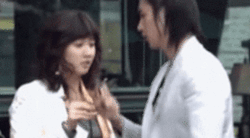
(originariamente postata da dilebe06)
[SPOILER] Il drama mi è piaciuto moltissimo, ma il finale era un po’... incompleto. Per carità, non è che volessi chissà cosa, ma credo che dopo tutta la fatica che hanno fatto i due a incontrarsi, mi meritassi e si meritassero qualcosa di più del “forse si incontreranno perché sono destinati”. Eh, okay, ma mi sarebbe bastato anche vederli incrociarsi e notarsi. Autori infami e ingrati.
30) Miglior Bromance: Someday or One Day

(precedentemente postata da ij997)
In realtà qui avevo intenzione di mettere Circle, ma dato che anche Someday era in lista e Circle volevo inserirlo per la stessa motivazione in un’altra categoria più avanti, alla fine hanno prevalso i due amici di Someday or One Day.
Li Zi Wei e Mo Jun Jie, entrambi personaggi sfigatissimi, uniti da una profonda amicizia che è partita dall’infanzia fino a… fattacci.
Sono rimasti uniti nonostante a volte litigassero, nonostante le incomprensioni, nonostante parte dei fattacci di cui sopra, nonostante a entrambi piacesse la stessa ragazza (ma in realtà no). La scena bonus non ha fatto altro che rendere tutto più dolce.
31) Miglior attore e Migliore attrice: It’s Okay Not To Be Okay e Someday or One Day
Per gli uomini, mi sarebbe piaciuto tantissimo premiare Darren Chen (che quasi non ho riconosciuto seguendo My Unicorn Girl per quanto era migliorato), ma alla fine ha prevalso Oh Jung Se per il suo ruolo di Moon San Tae in It’s Okay Not To Be Okay. Ha interpretato in modo realistico il suo personaggio e il disturbo - l’autismo - di cui soffriva, così come lo sviluppo caratteriale e il rapporto con il fratello e la protagonista. E’ stato l’attore che mi ha colpito maggiormente in tutto il drama.
Alice Ke non ha solo dovuto interpretare due personaggi diversi per Someday or One Day che erano praticamente agli opposti, ma a volte anche una che si fingeva l’altra e lo faceva in modo eccelso. E’ stata così brava nel ruolo che molto spesso ti scordavi che l’attrice era la stessa e non due diverse, al punto che adoravo la protagonista così come mal sopportavo la Depressa e non contava affatto che avessero la stessa faccia. Bravissima.
32) Il personaggio che hai amato di più: Beautiful World
Ovviamente ho escluso Li Zi Wei di Someday Or One Day perché ho perso il conto delle volte in cui ho nominato questo drama nel quizzone.
Alla fine ho voluto andare sul non banale e ho scelto Joon Seok. Personaggio davvero interessante. Era pieno di contraddizioni, mi è piaciuto proprio per questo. Se da un lato sembrava che degli altri non gliene fregasse nulla, dall'altro era devastato per Seun Ho e le sue azioni. E' sostanzialmente un bravo ragazzo, ma con dei lati oscuri (qualche tendenza sociopatica per esempio), che anziché essere soffocati, sono stati portati all'eccesso dal comportamento inqualificabile dei propri genitori. Badate bene, Joon Seok non è un santo, è piuttosto menefreghista e ha tendenze violente, ma anche l'ambiente in cui si cresce conta e quello in cui viveva questo ragazzo era terribile sotto ogni aspetto. E' stato interessante scoprire sempre più lati di lui man mano che la serie proseguiva che lo hanno reso un personaggio completo.
33) il personaggio che hai odiato di più: Love Better Than Immortality
Ovviamente, non scelgo mai un antagonista per questa categoria, sarebbe troppo vincere facile, quindi ecco il personaggio più odioso che in teoria non dovrei odiare: Xiao Bai di Love Better than Immortality, aka il second lead del drama. Il bello è che i primi… venti-trenta minuti, lui sembra il protagonista e anche se non capisci perché subito percepisci che gli manca qualcosa (il carisma) e ci resti male. Poi compare finalmente il protagonista, lo guardi e fai: aaaaaah (cit. Il Trono del Muori).
All’inizio non lo odi subito, è una cosa che si sviluppa con il tempo. Perché man mano che il personaggio si sviluppa, ti rendi conto quanto sia insopportabile e arrogante, come si creda questo grande eroe che patteggia per il bene e invece è solo uno stupido che farebbe cose anche crudeli e immorali per raggiungere quello che pensa sia giusto. Quella sua supponenza mi ha irritato sempre e sempre di più.
34) Quale personaggio vorresti essere e quale no?: Romance is a Bonus Book e Kleun Cheewit (2017)
Sì, ma... il 99% dei personaggi sono minimo orfani e hanno passato le peggiori disgrazie, che domanda è?
Comunque... Dan-I di Romance is a Bonus Book che (togliamo la parte del matrimonio fallito) finisce a lavorare in una libreria (<3) e le viene dietro un Lee Jonk Suk particolarmente affascinante da ANNI. Ovviamente io sarei molto meno stupida di lei.
Mentre non vorrei mai essere Jee di Kleun Cheewit, questa povera ragazza ne passa di tutti i colori. Viene drogata dal patrigno e quasi aggredita, riesce a scappare e investe una poveraccia per sbaglio a causa della droga che le era stata iniettata, viene trattata male dalle colleghe invidiose o gelose, dal lead che la odia perché gli ha investito la fidanzata, viene inseguita, ricattata, sparata, le muore l’unica persona che le voleva bene a un certo punto le viene pure la febbre e la madre si ricorda di esserlo solo dopo tipo... 12 puntate su 15. Ed è pure una brava persona!
35) Quale drama meriterebbe un sequel?: Circle
Non credo nei sequel, ma ammetto che mi piacerebbe veder risolte le cose lasciate in sospeso con Circle, vedi tutta la storia della protagonista e quel cliffhanger lasciato in sospeso alla fine. Sicuramente ci sarebbe abbastanza materiale almeno per dieci episodi. E comunque in generale non mi dispiacerebbe rivedere tutti i personaggi.
36) Una frase o una scena che ti è rimasta impressa ancora oggi: My Unicorn Girl
E’ un po’ barare, ma voglio premiare My Unicorn Girl per essere riuscito a fare una storyline sulle parole “ti amo” e renderla romantica e divertentissima al tempo stesso. Ogni volta mi ammazzavo dal ridere per la protagonista che le ripeteva (con un accento abbastanza terribile) senza rendersi conto del loro vero significato.
Scena bonus SPOILER CRASH LANDING ON YOU: Il canto del cigno del second lead, con lui che decide di non scappare per l’ennesima volta, si arma di fucile e va a salvare la second lead.
37) Di quale drama faresti un rewatch adesso?: Someday or One Day
Odio i rewatch, io sono più per il rivedermi le scene piaciute più che la serie da capo, ma onestamente vorrei darmi un colpo in testa o usare il chip di Circle, dimenticarmi completamente di Someday or One Day e rivederla come se fosse la prima volta. E poi di nuovo. E di nuovo.
38) I 3 attori e le 3 attrici più belle: Kleun Cheewit (2017), It’s Okay Not To Be Okay, Lost Romance; Someday or One Day, My Unicorn Girl, Love Better Than Immortality
Donne: Yaya Urassaya Sperbund (Kleun Cheewit), Seo Ye Ji (It’s Okay Not To Be Okay), Kelly Liao (Lost Romance).
Uomini: Greg Hsu (Someday Or One Day), Darren Chen (My Unicorn Girl), Li Hong Yi (Love Better Than Immortality).
39) Un drama per riflettere, uno per piangere ed uno per rilassarti: Circle per riflettere, Autumn’s Concerto per piangere, My Unicorn Girl per rilassarsi
Avrei potuto vincere facile e scegliere Someday or One Day, ma no… doveva essere Circle. Quel drama che mi ha fatto riflettere sui chip che sopprimono i ricordi brutti permettendo alla persona di vivere con serenità. Mi ha fatto pensare che poteva essere una bella favola. Nonostante ritenessi già all’inizio che siamo quel che siamo per i nostri ricordi, tutti i nostri ricordi. Circle è una serie che fa pensare dall’inizio alla fine ed è uno dei suoi meriti.
Autumn’s Concerto, sebbene non sia angosciante come sembra presupporre la trama (tra malattie gravi e amnesie) è comunque un drama molto commovente, soprattutto nella prima parte, con Ren Guang Xi che scopre di essere malato poco dopo essersi innamorato della protagonista, che deve affrontare una situazione veramente difficile, tra dolori atroci e un’operazione rischiosa alle porte, con anche la madre che trama alle sue spalle e al fianco una persona che non fa che mentirgli (sì, Mu Cheng, ancora non ti ho perdonata), decisamente un periodo non facile e il drama trasmette alla perfezione tutto questo dolore.
Ho visto My Unicorn Girl nel classico momento giusto. Avevo bisogno di una serie con livello di stress inferiore allo zero e questa era PERFETTA. Lo vedevo proprio volentieri perché ogni episodio erano quaranta minuti di puro intrattenimento. Tra l’altro, anche Lost Romance è una serie simile ma con una qualità maggiore.
40) Peggior attore e peggior attrice: Love By Chance 2 e The Bride of Habaek
Plan Rathavit Kijworalak di Love By Chance perché anche se ho notato un leggero, infinitesimale miglioramento rispetto alla prima stagione, paga il fatto di essere il protagonista insieme a Mean questa volta, e quindi il suo essere un po’ meglio non basta. E’ comunque... parecchio imbarazzante seguire la sua recitazione, e in generale i tentativi di fargli avere scene romantiche con Mean con scarsi risultati.
Ero invece parecchio indecisa con l’attrice femminile perché non me n’è venuta in mente nessuna particolarmente terribile, quindi Shin Se Jyung di The Bride of Habaek paga il fatto che il drama mi ha annoiato da morire (inspiegabile che io l’abbia finito) e che la sua recitazione non fosse proprio nulla di che.
41) Una ship fittizia che shippi?: Circle
Ho adorato tantissimo i due protagonisti maschili della parte ambientata nel 2037 di Circle. Avevano una chimica immensa, litigavano come una coppia sposata, hanno avuto dei conflitti e tenevano l’uno all’altro. Una shipper come me con una cosa del genere ci poteva solo andare a nozze. E così è stato.
42) Una serie che merita più conoscenza: Someday or One Day
Se non me l’avessero consigliata, io questa serie probabilmente non l’avrei mai vista (anche perché la locandina è meh). E’ uscita lo scorso anno, ma non rammento di averne mai sentito parlare. E no, non va bene, perché se arrivo a dare 10 a una serie, allora quella serie sicuramente merita di essere conosciuta molto, molto di più. Vi rendete conto che avrei potuto non vederla MAI? Che perla mi sarei persa?
43) Se potessi resuscitare qualcuno…chi sarebbe?: Someday or One Day

(precedentemente postata da heynicki)
Il Wang originale di Someday or One Day ha avuto 5 minuti di scena (di numero), ma mi hanno colpito talmente tanto che avrei voluto vedere molto di più su di lui, avrei voluto uno spin-off, magari uno in cui si riprendeva (beh, tecnicamente sarebbe in coma irreversibile, ma direi che conta come morte) e viveva la sua vita e magari conosceva un ragazzo fantastico che lo avrebbe meritato. Tutto questo in 5 minuti, figuratevi se gli avessero dedicato un episodio intero, gli avrei fatto una statua.
44) Un oggetto/potere/abilità che vorresti: To Get Her
Il macchinario di To Get Her, magari funzionante, che ti permetteva di entrare nel videogioco e praticamente viverci dentro (al punto che realtà virtuale scansati che non vali niente), e ritornare nel presente se finisci le vite. Tra l’altro mentre nel videogioco passano anche mesi, nel mondo reale sono pochi minuti, quanto sarebbe divertente!
45) Se potessi uscire con un personaggio di un drama, chi sarebbe?: Romance is a Bonus Book
Solo uno?
Cha Eun Ho, interpretato da Lee Jong Suk, era particolarmente affascinante e “charming” in questo drama, con il suo lavorare in una casa editrice e l’essere l’uomo che chiunque con un po’ di sale in zucca vorrebbe (tra Dan-I, perché lei è matta).
INFINE…UNA CHALLENGE: io so che nella lista avete drama inseriti nella categoria “prima o poi lo vedrò” e che ormai vegetano lì da mesi e mesi.
Bene, è ora di tenere fede agli impegni!
Prometto di recuperare Battle of Changsha (che è bello pesantuccio) e Doctor Stranger, entrambi del 2014, entro la fine del 2021! (Ce la farò???)
E con questo abbiamo finito! Anche quest’anno il quizzone è stato divertentissimo e se siete arrivati a leggere fino a qui... complimenti!
9 notes
·
View notes
Text
BTS ' blood sweat & Tears Japanese ver mv ' Colours meanings/Code theory
No one can ignore the strong Colours shifting through BS&T jap ver MV! & of course it’s not Random (BH Do Everything For A Reason)!There are Already so many Great theories regarding symbolism, So Here I will just Write about colours as the title Sets.
I know it’s too late to write about this, But I didn’t find anyone Do a separated article So Why Not? (I’m a New ‘April019’ ARMY HeHe)
Sorry for the long Intro (•^•) …. LET’S START. READY? SET, GO: (its long, brainstorming & All; so Bring snacks)

Colours that keep appearing on the mv are Blue, Red, Green, Purple & somehow Yellow. let me explain each one of them shortly & then Clarify How do they together interfere with the symbolism!! (let's assume there two personifications of each member adult persona immature one)
First: BLUE:
Blue represents the Wisdom & stability of being Mature.
Suga & jhope Aura (adulthood)
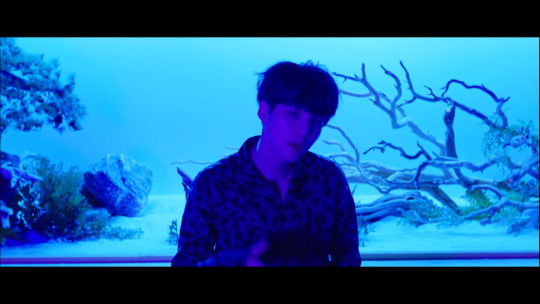
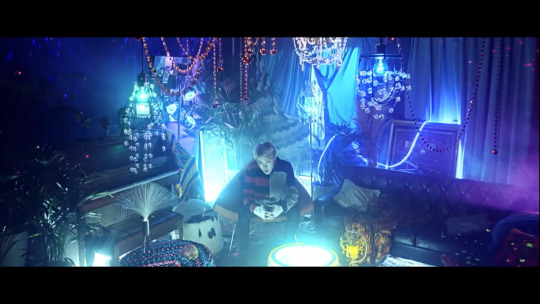
JHope dancing on a Blue background:
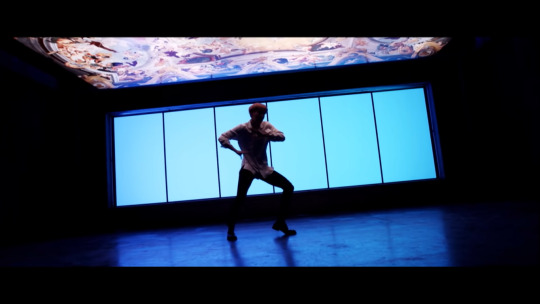
Young jimin looking around feeling unfamiliarity towards adulthood (blue room)
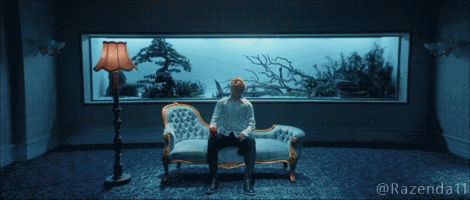
Second: RED:
Red refers to Juvenile joy & pure Passion of youth.
Here is young jimin


-Young jin Gazing at ‘The crash of the fallen Angels’ painting & His sight is all red (being on pure realm realizing the existence of dark)
The painting actually depicts the rebellious angels dragging Down other angels to Hell.

Young jungkook aura

Even V :

Jimin dancing on a RED background :

THIRED: PURPLE
Purple is the colour of mystery, symbolizing The unknown complex Feeling of Meeting the devil & Facing maturity Pain! The cruelty of realizing the existence of the Dark realm. Mixing Red (childhood) + Blue (adulthood) → Purple (Between them: Youth)
-J-Hope’s Legend ’ Wings comeback trailer: BOY MEETS EVIL ’ aura portrays it perfectly. Clearly the whole MV is on Purple background:

Jungkook awakes finding purple Blood mark (maturity pain) showing wings (maybe his wings are protruding?)

Jimin eating an Apple (apple symbolizes temptation sin forbidden apple of garden eden)
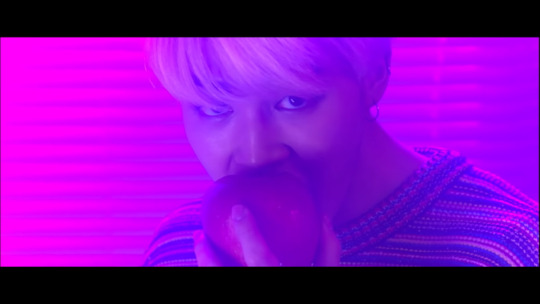
The scene of Jin suffering
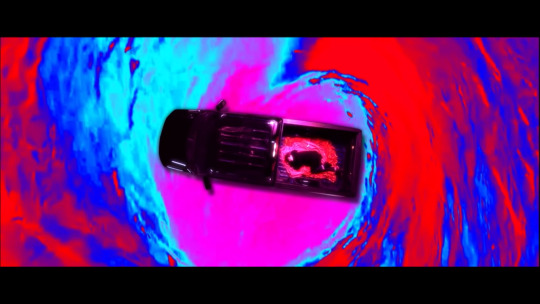
V dazing, as if he is Drunk?
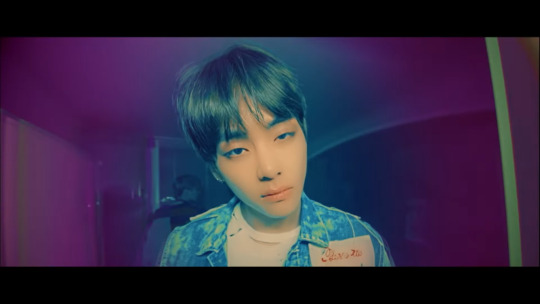
GREEN:
One of Green colour meanings is ’ Rebirth’. Reminding me of ‘DEMIAN’s Breaking the Egg concept (Demain: a novel by Hermann Hesse the inspiration of Wings album entirely I’m sure you know about this) Green is to Shake Hands with the Devil, to Sin! This colour meaning is the most obvious on the MV & Even clearer on the Original ver (Korean one):
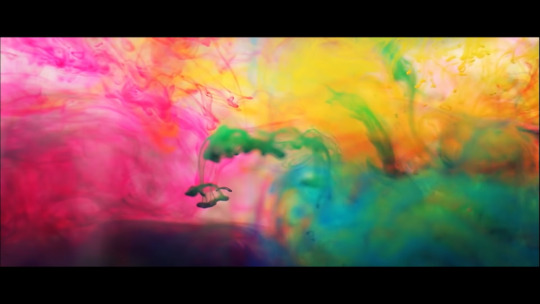
Jimin Here is literally mixing the apple with the juice then it turns into green

Let’s talk about the most interesting scene (ladies & gentlemen Fasten your Belts!!)
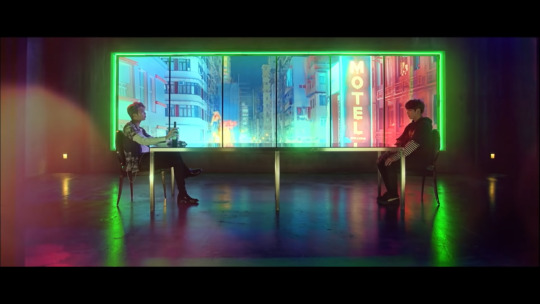
Okay ehm ehm we have a residence on blue light & RM siting so manly on the left side (adulthood) (the residence represents stability)
A Hotel on Red light & jungkook siting so politely on the Right side (youth) (the motel represents uneasiness of the young)
In the Frame we got a green light as RM is about to offer a liquor to jk (SIN, ruining purity).
(As you see the scene proves my whole theory.)
What happens after jk is forced to drink the liquor?

His surroundings become BLUE & he Looks dazed cause The maturity is hitting him so hard.
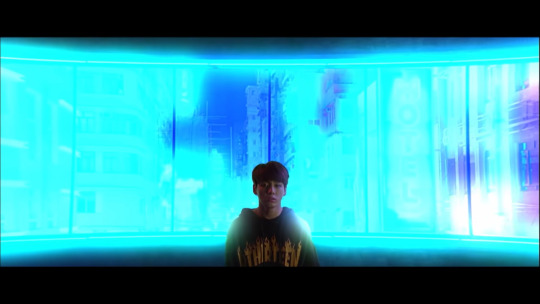
Then a yellow light!

(I will explain it further Below)
YELLOW:
yellow = Enlightenment !! the exact moment of noticing the wickedness.
the painting jin looking at is on yellow (the actual painting is colourful) (enlightenment) even the Binocular is Golden LOL
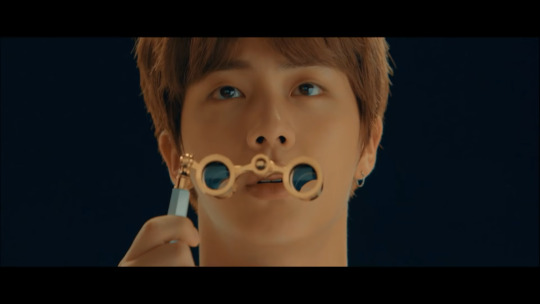

getting back to the very start: jk waking up looking surprised inside a ’ mainly ’ yellow room, even the light above him is yellow!(enlightenment) other colours are green & purple (the pain of realizing the evil is reason he astonished)

On the wall Colours are painted in a way looks as they’re jk’s wings woow!!
-Jhope sits in front of ‘Pietà ’: (a subject in Christian art depicting the virgin Mary cradling the dead body of Jesus) pointing an arrow (if we consider it as pointing to his left symbolizes warding off evil if right protection. both meanings interfere with being on motherhood realm) the lights are purple + yellow
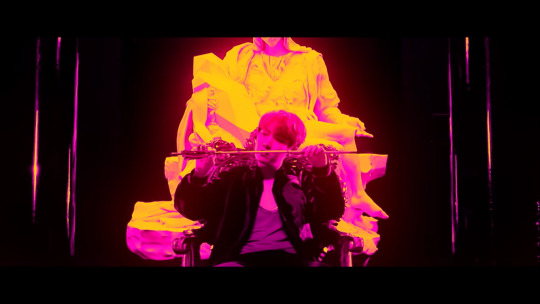
Keep reading if you Don’t wanna miss the real joy! (bring a cup of coffee it’s deepening)
Further Explanation:
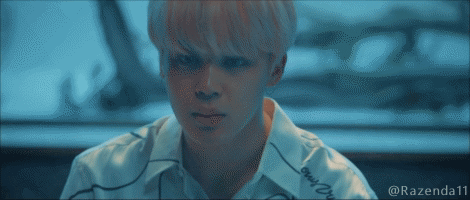
Young jimin (Red lighted) looks at His maturing-self in the way reaching Adulthood (the one inside Blue room) & suga quickly covers his eyes as he looks Hesitant to eat the apple (to accept his fate going through maturity). (What if jimin is just a visitor on Suga own world (as suga is his mentor, showing him the way toendure maturity)? I mean in the mv beginning there is a piano (suga first love) who knows!! (yall lets appreciate how the walls looks like piano inside)



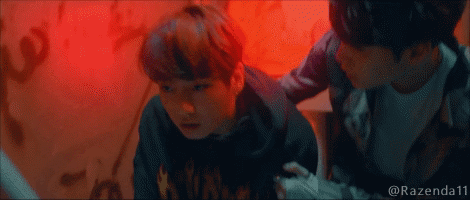
jk entering a restroom in a red light to spit out the Green liquor (going back to his pure young side refusing maturity) suga is trying to stop Him (encouraging jk to handle maturity soreness move on) feels like the same thing suga did with jimin when he closed jimins eyes preventing him from yearning & longing to his pure young-self. but jk pushed him away!!
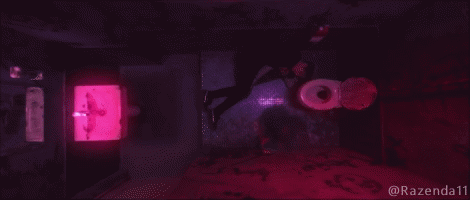
lights changed to purple jk fainted + black smoke spreads
jhope pulling an arrow (pulling an arrow back symbolizes conflict tension life struggle facing maturity releasing it from the bow represents positive transition in one moving forward mature)colours meanings of Yellow & purple interfere.

Is jhope pulling the arrow towards V? Does He want to Help V breaking His world? (OH! Does it sounds strange? Then let me quote the most famous line of the novel DEMIAN: ‘the bird fight its way out of the egg. the egg is the world. who would be born should first destroy a world’ I’m Gonna use this concept a lot so please put it on mind.)

-V is Suffering inside a blue veil, trying to be out to the Red surroundings but couldn’t(v agonizes maturity pain desires his youth back)
What Do you see?
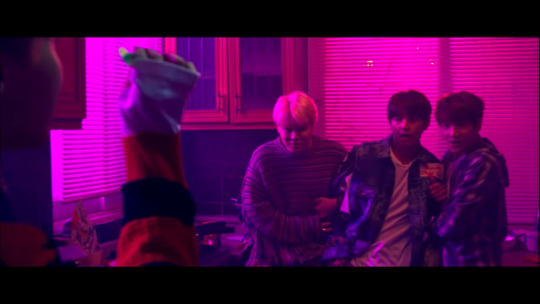
On a purple light Jimin & jungook holding V, V looks worried & scared, Jhopes hand aiming something Green towards him (not sure what is it, Green small arrow?) (the point is jhope about to ruin v pure youth)
If you gonna argue how on earth I know it’s jhope’s hand then:

Same shirt!! yeah .
As jhope ruins V purity the arrow is pulled, it hits white bringing in green & red (hitting purity: youth been ruined)

Jhope on a blue room wearing half Blue half red T-shirt (mature jhope is aware about adulthood youth) throwing pills into a yellow can while smiling (jhope is no longer suffering letting go of his past struggles he throws pain away) (jhope’s facial expressions says it All

Look at this again (oc I didn’t take this screenshot to convince u about jhope t-shirt sleeve only haha)

On this scene it Seems like all members are already matured (the way they sit) leaving the pain behind them as they watch jhope throwing the pills. jk with a blue lollipop (matured) (I couldn’t point out all but) suga’s piano, Rm mirrors, curtains (jin) all behind. Also there’re so many small palms all around the room (palms symbolize victory triumph peace as they overcome the struggle)

¬
RM’s room is Red & green: on green light there’re so many red items ‘roses, curtains’ even the walls painting is red-green scratches! but How?
(I know what’re you thinking now: like ‘why isn’t it purple you’re manipulating.’ Just keep reading)
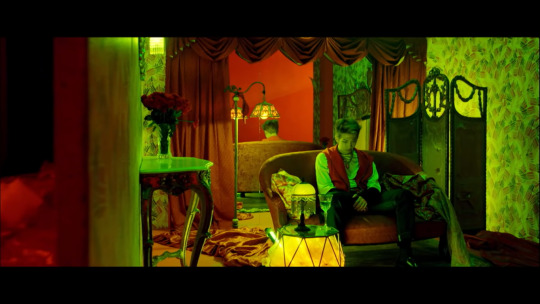
first Look at the very left, the surrounding of the room is Red (the director could cut it to directly show the inside but bighit is leaving clues) or simply mirror’s reflection shows Red. So Rm is actually on his young realm which is starting to be ruined. this scene timing comes with jk being forced to drink (which are very interfering with youth being ruined concept). Red roses symbolize romance love + in front of Rm there’s the same cup of Green liquor he offers to jk (both ruins purity) the existence of the dressing partition & the mirror support the idea of RM being his young-self (changing cloths symbolizes personality changing the reflection refers to self-reflecting ego shows instability of youth)
Still not convinced? What if this whole scene is made to prove Yellow meaning? (green and red mixture makes yellow: pure youth being ruined so one be enlightened)
Rm looking at his reflection the light changes to yellow while the lyrics goes ‘the wings resemble the Devil’(rm acknowledges what looks devil to him is makes mature gives wings fly) (his facial expression be like I know it all now)
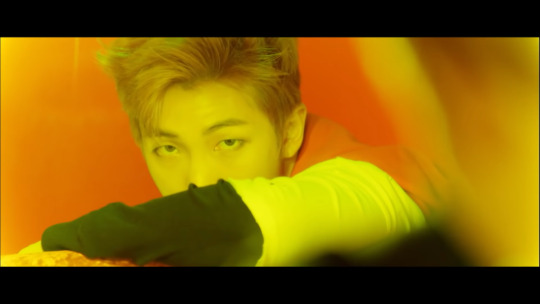
you see now? it’s a state of enlightenment not suffering this is why there’s no purple. What happens after that?
The mirror breaks into pieces & the Blue rays shine (as rm breaks his egg finding way out to maturity concept)

¬ Mixing specific shades of Green & Red doesn’t give yellow but Brown. on the mv Brown appears on some scenes giving the same meaning of yellow:
-Jin’s scarf before it gets purple lighted:

-The lamp

The painting

Curtains & the sofa
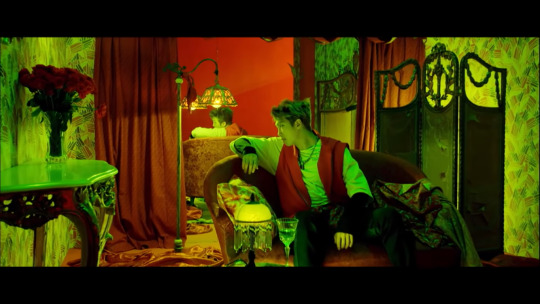
& here, HERE!!

¬ what’s going on here?

Blue lighted V is scratching a Green wall walking up stairs (mature v is rebelling he wants to go back his young-self) (look at the thing he’s scratching by it is Red.)
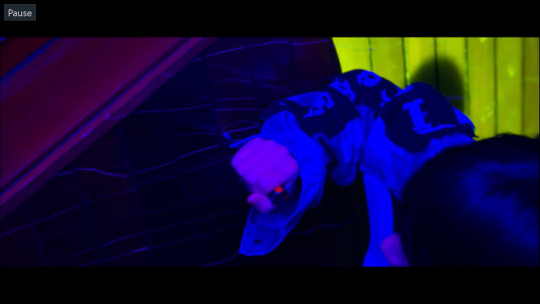
The colours gradually change ‘Green, purple, then Red’ from down to up, as V is trying to return to his pure youth BUT!…
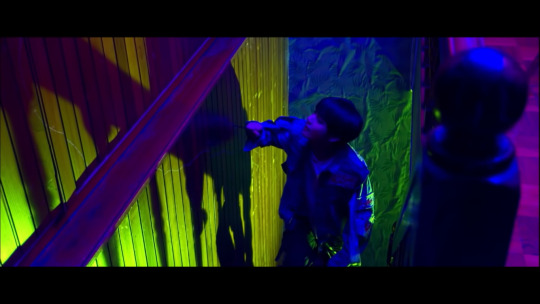



V finds out there is no way back, he is already trapped as the whole sky is ruined green & his world is changing.

- The fact that youth & adulthood are unseparated is expressed a lot through the mv specially at the ending:
What bangtan is telling us is that “it’s alright!” Maturing is hard, painful, storming & makes you feel not yourself but “it’s alright!” Sensing the existence of the evil, passing by it or even commiting it- doesn’t mean that’s who you are. You’re just maturing. Forgive yourself Learn & move on.
Jin young world falling apart:
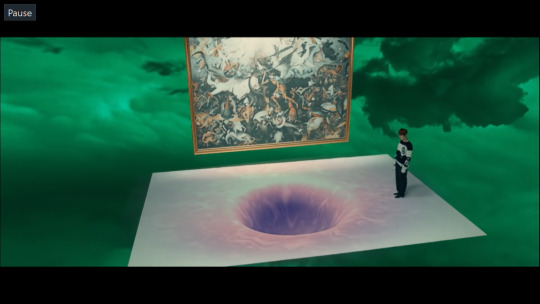


The room jk awakes in breaks down (it Goes from yellow to green then into blue/ a galaxy of Red, blue, yellow & purple interfere)

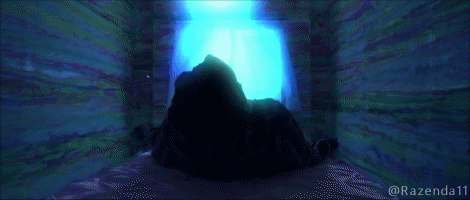
Scares on Rm hands left after the mirror breaks, the room is no longer Red but green & yellow. (the paint that Revealed on the wall is “the Fall of Icarus” by Pieter Bruegel: Icarus fell from flying too close to the sun. Allegory of pride, youth & the dangers of going to extremes) see? very interfering.
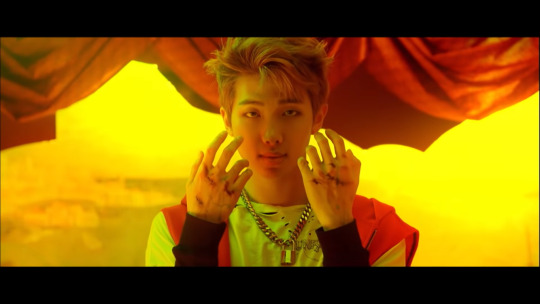

Look here(Red through blue/ Green through blue):
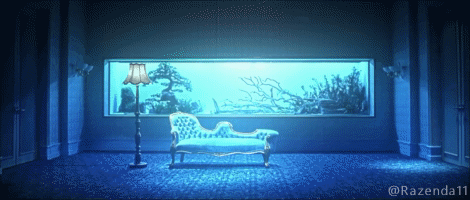
Green & Blue crossing:

Bonus:
The station RM works on (you can see the Red though everything is black & white):
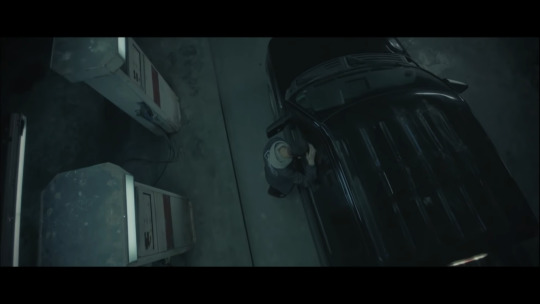
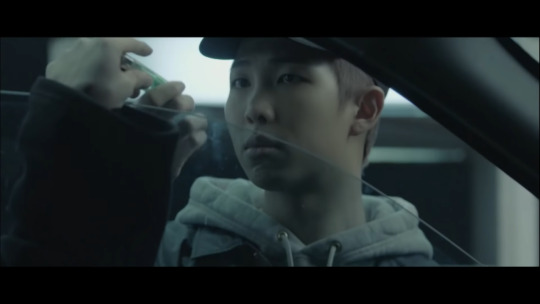

Jin gives RM a Green lighter!!!
Trivia: I’m sorry if anything sounds wired or clingy I’m not native, I truly tried my best wording this theory but English isn’t my first language after all. Please support me.
#bts#bts mv theory#bts theory#bangtan#bts senarios#bts world#bts wings#bs&t#japanese version#boy meets evil#bts japan
64 notes
·
View notes
Text
Reading Response #3

🔍 Thoughts on “The Basics: Icons and Iconoclasm” and “The Great Debate: Iconoclasts vs. Iconophiles”
It was interesting to learn what icons are, and how people used them in worshiping God. Essentially it was (or is?) believed that the object (icon) contained the divinity of the holy figure it depicted through the image of the person’s likeness. When that holy figure was venerated in prayer, he or she would be able to respond (through the icon) to the needs of the person praying..
To be honest, I don’t agree with these beliefs, which leads me to believe that I might identify more with the iconoclasts than the iconophiles. (Though I would not go so far as to destroy any religious icons!) I just don’t agree that the divinity of Christ could be stored in a physical object based on an artist’s interpretation of His likeness. I think at that point, according to that belief, the icon has the potential to become an idol. One would be dependent on a physical object depicting Jesus in order to pray, and that’s not doctrinally accurate. Furthermore, one may find it easy to focus too much on the artwork/icon itself, which detracts from the worship of God. This gets especially tricky when the icon depicts the Virgin Mary or one of the saints or apostles. These people––though worthy of admiration––were not divine, and therefore it’s idolatry to pray to them or to artistic renditions of them. Thus, it’s very important to understand that line between engaging with artwork and idolatry. Appreciating religious icons is okay, but worshipping and attributing power to them is not.
I don’t think there’s anything wrong with artistic renditions of Jesus, Mary, or any of the saints and apostles; in fact, I agree that they can be helpful visual reminders of these people’s existences here on Earth. I can especially appreciate John of Damascus’ argument about how icons of the saints show the piety of regular, ordinary people. A lot of talent and purpose was put into the making of icons, and they aren’t idols just because they depict notable figures. They only become idols when people focus too much on the artwork/object rather than on their worship of God.
I’ve never really considered how artwork becomes idolatry in a modern sense. However, I think art has the capacity to become an idol when we elevate it too much. Art is wonderful, and valuable, but it cannot take God’s place in our lives. It can serve to reveal God’s presence and character, but it shouldn’t be revered more than Him.
🔍 Thoughts on “Art and an Integrated Worldview” PDF
I found this article fascinating. The author points out how the secular world seeks spirituality through art (giving art too high a role), and how the Christian world is suspicious of art because it’s allegedly too worldly (giving art too low a role). Both these viewpoints lead to dualism. Dualism is a problem, because it forces things to be either good or bad. Throughout church history, certain cultural aspects have been banned because of dualism (dancing, organs, bonnet ribbons, etc). There’s nothing inherently wrong with these things; they’ve just been classified as “bad” (or “too worldly”) by the church based on dualistic views.
I love how the author counters dualism, highlighting how the Bible conveys truths in terms of both/and (rather than either/or). For example, creation is both gloriously beautiful and tainted by sin; humanity is both made in God’s image and fallen; Jesus is both fully human and fully divine….” These aren’t contradictions––they’re truths. Likewise, we cannot say that art is either “right” or “wrong,” because it’s not black and white. Life in general is not black and white. The line between good and evil cannot be drawn compartmentally, deeming certain cultural aspects “good” and others “bad.” Instead, we have to filter good and bad, right and wrong, truth and lie based on the Bible’s truths. Therefore, I don’t think art is always “good/Christian” or always “bad/secular.”
🔍 Thoughts on “Art and Empathy” video
I personally love the empathetic capability of art. I love it when I can feel what a certain subject is feeling, or when a piece makes me stop and stare as I try to take in what it’s communicating. I thought it was interesting how Catholic writers in the late Middle Ages began to focus more on Jesus’ humanity, which began a new artistic movement. This shift brought the focus more on Jesus’ ability to relate with us, and enabled artists to create in order to inspire empathy for “the suffering of Jesus and Mary,” while also conveying that the two could understand the viewer’s own suffering (thus highlighting Jesus and Mary’s humanity).
I also really love that art’s empathetic power can be used to inspire action. The video highlighted how the US Government’s Farm Security Administration hired photographers to take pictures taken during the Great Depression and Dust Bowl. These then served to arouse empathy for those who were suffering, which helped to provide funding to those in need, and to show the truth about the poverty those people faced.
Also, the Vietnam Veterans Memorial in Washington DC is an excellent example of art being used to show compassion and support. The memorial helps visitors empathize with those who lost their lives, with the families who have lost members to the war, and with the effects of the war itself. I’ve actually visited this memorial, and I love the design of the wall. One of my favorite parts is how the black marble is reflective, which allows the viewer to become part of the monument.
All in all, I just think it’s incredible what artwork can accomplish when utilized well; it can lead to action, inspire empathy, and form connections, among other things. I’m starting to see that art is a lot bigger than I thought it was!
📷 Image Above:
The Austrian Pietà: https://www.google.com/search?q=austrian+pieta&tbm=isch&ved=2ahUKEwjm_Nunw-rrAhUKAzQIHVcrDXgQ2-cCegQIABAA&oq=austrian+pieta&gs_lcp=CgNpbWcQAzoECCMQJzoCCAA6BQgAELEDOggIABCxAxCDAToECAAQQzoHCAAQsQMQQzoGCAAQCBAeOgQIABAYULWbBFitwARgn8QEaABwAHgAgAFLiAGAB5IBAjE0mAEAoAEBqgELZ3dzLXdpei1pbWfAAQE&sclient=img&ei=LF5gX-a2EIqG0PEP19a0wAc&bih=789&biw=1440#imgrc=xDhoerUCTj9WfM
1 note
·
View note
Note
Exactly. I don't know why people are criticizing this idea so much. It is WAY better than the other types of horrible ways this film could have gone. Like, Kylo remains evil and Rey kills him triumphantly, or there is no Reylo interaction until the climax where they hatefully fight each other, or they turn out to be relatives, or Rey gets rid of irredeemable loser Kylo and becomes an honorary bearer of the Skywalker legacy...I will gladly take the MSW rumored climax over THAT nonsense.
To be honest, I LOVE this scenario. It’s the perfect mix of angst and tragedy and cheesy, unapologetic romanticism. It would showcase perfectly how much both Rey and Kylo love each other. It solves neatly the issue of “maybe Ben Solo needs to be redeemed BUT Kylo Ren has to pay for his crimes”. It’s exactly the sort of over the top self-sacrificial act I would expect from someone as extra as Ben. It proves how extraordinarily strong he is, to be able to contain within himself the pure essence of evil and not be immediately consumed. I need to stop or I’ll get too attached to this scenario and it’s not a good idea since we still don’t know how legit the leak is, lol.
I guess people’s problem is Rey’s willingness to go for it? But if you’ve seen Infinity War, you’ll know that this is a tragic soulmates trope, not an “okay, I’ll do it, I’ll put the rabid dog to sleep and go on on my merry way” one, lol. If they go this way, the chances we are also getting a Pietà scene and a beauty and the beast resurrection sequence SKYROCKET.
(and no, this isn’t necessarily at odds with the spirit of star wars, provided it’s immediately followed with a rebirth of some sort. In this context, the self sacrifice is on BOTH Rey and Kylo’s parts.)
16 notes
·
View notes
Text
Christianity - Chapters
Last edited 2019-07-04
Becker, Michael. “Paul and the Evil One.” In Evil and the Devil, edited by Ida Frölich and Erkki Koskenniemi, 127-141. London, UK: Bloomsbury, 2013.
Bernstein, Alan E. “The Ghostly Troop and the Battle Over Death: William of Auvergne (d. 1249) Connects Christian, Old Norse, and Irish Views.” In Rethinking Ghosts in World Religions, edited by Mu-chou Poo, 115-162. Leiden: Brill, 2009.
Birman, Patricia. “Sorcery, Territories, and Marginal Resistances in Rio de Janeiro.” In Sorcery in the Black Atlantic, edited by Luis Nicolau Páres and Roger Sansi, 209-231. Chicago, IL: University of Chicago Press, 2011.
Bozóky, Edina. “Mythic Mediation in Healing Incantations.” In Health, Disease and Healing in Medieval Culture, edited by Sheila Campbell, Bert Hall, and David Klausner, 84-92. New York: St. Martin’s Press, 1991.
* Cusack, Carole M. “Brigit: Goddess, Saint, ‘Holy Woman’, and Bone of Contention.” In On a Panegyrical Note: Studies in Honour of Garry W. Trompf, edited by Victoria Barker and Frances Di Lauro. Sydney, Australia: University of Sydney, 2007.
* DeConick, April D. “What Is Early Jewish and Christian Mysticism?” In Paradise Now: Essays on Early Jewish and Christian Mysticism, edited by April D. DeConick, 1-24. Atlanta, GA: Society for Biblical Literature, 2006.
Dochhorn, Jan. “The Devil in the Gospel of Mark.” In Evil and the Devil, edited by Ida Frölich, 98-107. London: Bloomsbury, 2013.
* Epstein, Mikhail. “Daniil Andreev and the Russian Mysticism of Femininity.” In The Occult in Russian and Soviet Culture, edited by Bernice Glatzer Rosenthal, 325-355. Ithaca: Cornell University Press, 1997.
* Fanger, Claire. “Complications of Eros: The Song of Songs in John of Morigny’s Liber Florum Celestis Doctrine.” In Hidden Intercourse: Eros and Sexuality in the History of Western Esotericism, edited by Wouter J. Hanegraaff and Jeffrey J. Kripal, 153-174. Leiden: Brill, 2008.
* –. “God’s Occulted Body: On the Hiddenness of Christ in Alan of Lille’s Anticlaudianus.” In Histories of the Hidden God: Concealment and Revelation in Western Gnostic, Esoteric, and Mystical Traditions, edited by April D. DeConick and Grant Adamson, 101-119. New York: Acumen, 2013.
* –. “Introduction: Theurgy, Magic, and Mysticism.” In Invoking Angels: Theurgic Ideas and Practices, Thirteenth to Sixteenth Centuries, edited by Claire Fanger, 1-33. University Park: Penn State University Press, 2012.
* –. “Magic.” In The Oxford Guide to the Historical Reception of Augustine, edited by Karla Pollman and Willemien Otten, 860-865. Oxford: Oxford University Press, 2013.
* –. “Necromancy, Theurgy, and Intermediary Beings.” In Oxford Bibliographies in Medieval Studies, edited by Paul Szarmach, 1-5. New York: Oxford University Press, 2013.
* –. “Sacred and Secular Knowledge Systems in the “Ars Notoria” and the “Flowers of Heavenly Teaching” of John of Morigny.” In Die Enzyklopadie Der Esoterik; Allwissenheitsmythen und universalwissenschaftliche Modelle in der Esoterik der Neuzeit, edited by Andreas Kilcher and Philipp Thiesohn, 157-75. Paderborn: Wilhelm Fink Verlag, 2010.
* Frankfurter, David. “The Threat of Headless Beings: Constructing the Demonic in Christian Egypt.” In Fairies, Demons, and Nature Spirits: “Small Gods” at the Margins of Christendom, edited by Michael Ostling, 57-78. Basingstoke, UK: Palgrave Macmillan, 2018.
Gaffney, James. “The Relevance of Animal Experimentation to Roman Catholic Ethical Methodology.” In Animal Sacrifices: Religious Perspectives on the Use of Animals in Science, edited by Tom Regan, 149-170. Philadelphia, PA: Temple University Press, 1986.
Gordon, Stephen. “Domestic magic and the walking dead in medieval England: A diachronic approach.” In The Materiality of Magic: An artifactual investigation into ritual practices and popular beliefs, edited by Ceri Houlbrook and Natalie Armitage, 65-84. Oxford: Oxbow Books, 2015.
Hakola, Raimo. “The Believing Jews as the Children of the Devil in John 8.44: Similarity As a Treat to Social Identity.” In Evil and the Devil, edited by Ida Frölich and Erkki Koskenniemi, 116-126. London: Bloomsbury, 2013.
Hand, Wayland D. “Deformity, Disease, and Physical Ailment as Divine Retribution.” In Magical Medicine: The Folkloric Component of Medicine in the Belief, Custom, and Ritual of the Peoples of Europe and America, edited by Wayland D. Hand, 57-67. Berkeley: University of California,
Harrison, Beverly Wildung. “The Power of Anger in the Work of Love: Christian Ethics for Women and Other Strangers.” in Weaving the Visions: New Patterns in Feminist Spirituality, edited by Judith Plaskow and Carol P. Christ, 212-225. New York, NY: HarperCollins, 1989.
* Herzig, Tamar. “Stigmatized Holy Women as Female Christs.” In Archivio italiano per la storia della pietà 23, edited by Gábor Klaniczay, 149-174. Rome: Edizioni di Storia e Letteratura, 2013.
* Heyward, Carter. “Sexuality, Love, and Justice.” In Weaving the Visions: New Patterns in Feminist Spirituality, edited by Judith Plaskow and Carol P. Christ, 293-301. New York, NY: HarperCollins, 1989.
Hutton, Ronald. “Afterword.” In Fairies, Demons, and Nature Spirits: “Small Gods” at the Margins of Christendom, edited by Michael Ostling, 349-356. Basingstoke, UK: Palgrave Macmillan, 2018.
Inclusive Language Lectionary Committee of the National Council of Churches. “Selections from The Inclusive Language Lectionary.” In Weaving the Visions: New Patterns in Feminist Spirituality, edited by Judith Plaskow and Carol P. Christ, 163-169. New York, NY: HarperCollins, 1989.
Killen, Patricia O’Connell. “Conclusion: Religious Futures in the None Zone.” In Religion and Public Life in the Pacific Northwest: The None Zone, edited by Patricia O’Connell Killen and Mark Silk, 169-184. Walnut Creek: AltaMira Press, 2004.
Kornblatt, Judith Deutsch. “Russian Religious Thought and the Jewish Kabbala.” In The Occult in Russian and Soviet Culture, edited by Bernice Glatzer Rosenthal, 75-97. Ithaca: Cornell University Press, 1997.
Koskenniemi, Erkki. “Miracles of the Devil and His Assistants in Early Judaism and Their Influence on the Gospel of Matthew.” In Evil and the Devil, edited by Ida Frölich and Erkki Koskenniemi, 84-97. London: Bloomsbury, 2013.
Labahn, Michael. “The Dangerous Loser: The Narrative and Rhetorical Function of the Devil as Character in the Book of Revelation.” In Evil and the Devil, edited by Ida Frölich and Erkki Koskenniemi, 156-179. London: Bloomsbury, 2013.
Li, Shang-jen. “Ghost, Vampire, and Scientific Naturalism: Observation and Evidence in the Supernatural Fiction of Grant Allen, Bram Stoker and Arthur Conan Doyle.” In Rethinking Ghosts in World Religions, edited by Mu-chou Poo, 183-210. Leiden: Brill, 2009.
Linzey, Andrew. “The Place of Animals in Creation: A Christian View.” In Animal Sacrifices: Religious Perspectives on the Use of Animals in Science, edited by Tom Regan, 115-148. Philadelphia, PA: Temple University Press, 1986.
* Macfarlane, Alan. “A Tudor Anthropologist: George Gifford’s Discourse and Dialogue.” In The Damned Art: Essays in the Literature of Witchcraft, edited by Sydney Anglo, 140-155. Abingdon: Routledge, 2011.
* Martín Hernández, Raquel. “Appealing for Justice in Christian Magic.” In Cultures in Contact: Transfer of Knowledge in the Mediterranean Context: Selected Papers, edited by Sofía Torallas Tovar and Juan Pedro Monferrer-Sala, 27-41. Córdoba, Spain: Cordoba Near Eastern Research Unit, 2013.
Matter, E. Ann. “My Sister, My Spouse: Woman-Identified Women in Medieval Christianity.” In Weaving the Visions: New Patterns in Feminist Spirituality, edited by Judith Plaskow and Carol P. Christ, 51-62. New York, NY: HarperCollins, 1989.
McFague, Sallie. “God as Mother.” In Weaving the Visions: New Patterns in Feminist Spirituality, edited by Judith Plaskow and Carol P. Christ, 139-150. New York, NY: HarperCollins, 1989.
* Mildnerová, Kateřina. “’Obscene and diabolic and bloody fetishism’: European conceptualisation of Vodun through the history of Christian missions.” In Knowledge Production In and On Africa, edited by Hana Horáková and Kateřina Werkman, pp. 177-206. Zurich, Switzerland: Lit Verlag, 2016.
Nakashima Brock, Rita. “On Mirrors, Mists, and Murmurs: Toward an Asian American Thealogy.” In Weaving the Visions: New Patterns in Feminist Spirituality, edited by Judith Plaskow and Carol P. Christ, 235-243. New York, NY: HarperCollins, 1989.
Newall, Venetia. “Birds and Animals in Icon-Painting Tradition.” In Animals in Folklore, edited by J. R. Porter and W. M. S. Russell, 185-207. Cambridge, Ipswich, and Totowa: D. S. Brewer and Rowman & Littlefield, 1978.
* Ostling, Michael. “Introduction: Where’ve All the Good People Gone?” In Fairies, Demons and Nature Spirits: “Small Gods” at the Margins of Christendom, edited by Michael Ostling, 1-53. New York: Springer, 2017.
Paxton, Frederick S. “Anointing the Sick and the Dying in Christian Antiquity and the Early Medieval West.” In Health, Disease and Healing in Medieval Culture, edited by Sheila Campbell, Bert Hall, and David Klausner, 93-102. New York: St. Martin’s Press, 1991.
Pereira, Luena Nunes. “Families, Churches, the State, and the Child Witch in Angola.” Sorcery in the Black Atlantic, edited by Luis Nicolau Páres and Roger Sansi, 187-208. Chicago, IL: University of Chicago Press, 2011.
Ruether, Rosemary Radford. “Sexism and God-language.” In Weaving the Visions: New Patterns in Feminist Spirituality, edited by Judith Plaskow and Carol P. Christ, 151-162. New York, NY: HarperCollins, 1989.
Schüssler Fiorenza, Elisabeth. “In Search of Women’s History.” In Weaving the Visions: New Patterns in Feminist Spirituality, edited by Judith Plaskow and Carol P. Christ, 29-38. New York, NY: HarperCollins, 1989.
Shibley, Mark A. “Secular But Spiritual in the Pacific Northwest.” In Religion and Public Life in the Pacific Northwest: The None Zone, edited by Patricia O’Connell Killen and Mark Silk, 139-167. Walnut Creek: AltaMira Press, 2004.
Soder, Dale E. “Contesting the Soul of an Unlikely Land: Mainline Protestants, Catholics, and Reform and Conservative Jews in the Pacific Northwest.” In Religion and Public Life in the Pacific Northwest: The None Zone, edited by Patricia O’Connell Killen and Mark Silk, 51-78. Walnut Creek: AltaMira Press, 2004.
Thistlethwaite, Susan Brooks. “Every Two Minutes: Battered Women and Feminist Interpretation.” In Weaving the Visions: New Patterns in Feminist Spirituality, edited by Judith Plaskow and Carol P. Christ, 302-313. New York, NY: HarperCollins, 1989.
Thurén, Lauri. “1 Peter and the Lion.” In Evil and the Devil, edited by Ida Frölich and Erkki Koskenniemi, 142-155. London: Bloomsbury, 2013.
Tzvetkova-Glaser, Anna. “’Evil Is Not a Nature’: Origen on Evil and the Devil.” In Evil and the Devil, edited by Ida Frölich and Erkki Koskenniemi, 190-202. London: Bloomsbury, 2013.
Van Fleteren, Frederick. “Augustine and Evil.” In Evil and the Devil, edited by Ida Frölich and Erkki Koskenniemi, 180-189. London: Bloomsbury, 2013.
* Vidal, Fernando. “Ghosts of the European Enlightenment.” In Rethinking Ghosts in World Religions, edited by Mu-chou Poo, 163-182. Leiden: Brill, 2009.
Wellman, James K. “The Churching of the Pacific Northwest: The Rise of Sectarian Entrepreneurs.” In Religion and Public Life in the Pacific Northwest: The None Zone, edited by Patricia O’Connell Killen and Mark Silk, 79-105. Walnut Creek: AltaMira Press, 2004.
* Williams, Delores S. “Womanist Theology: Black Women’s Voices.” In Weaving the Visions: New Patterns in Feminist Spirituality, edited by Judith Plaskow and Carol P. Christ, 179-186. New York, NY: HarperCollins, 1989.
Wortley, John. “Three Not-So-Miraculous Miracles.” In Health, Disease and Healing in Medieval Culture, edited by Sheila Campbell, Bert Hall, and David Klausner, 160-168. New York: St. Martin’s Press, 1991.
Zier, Mark. “The Healing Power of the Hebrew Tongue: An Example from Late Thirteenth-Century England.” In Health, Disease and Healing in Medieval Culture, edited by Sheila Campbell, Bert Hall, and David Klausner, 103-118. New York: St. Martin’s Press, 1991.
2 notes
·
View notes
Text
Notes on “Girl Saints”
“The Angel said”
Is this line referring to the archangel Gabriel? What would G-d not already know the archangel’s counsel?
“Do not fall to the earth”
This sounds like it’s reflecting back to how the devil is referred to as a “fallen angel.” Is the Angel telling the narrator(s) not to go down the same path? Or is this talking about something else entirely?
“we were already stained in glass”
I love the different implications of this line. Firstly, by saying that the girls were already stained, that means that they’re irreparably dirty, and it’s a lovely piece of imagery. They’ve done something that cannot be fixed, and now they’re stained. They’re also already stained in glass. So by the time this counsel reached them, they had already done this horrible sin. Stained glass usually tells a story and it’s hung up for everyone to see - so these girls’ sin was already put into history and publicized. Also, it doesn’t say that their actions were stained in the glass, it says that the girls themselves were. I wonder if this is commentary on how fragile they and their situation was at this very moment.
“Starved girls folded at a line from Leviticus.”
I’m wondering which line folded these girls. Leviticus is filled with verses outlining punishments for women and forgiveness for men, so it’s kinda sad to say but it could be so many of them. This could be relating to Leviticus 12? This is the verse that outlines the holiness rituals for women after childbirth, and it’s the verse that states that women that give birth to a girl are ritually impure for double the time they would be if the child was a boy.
It could also be referring to Leviticus 19, which states that if a slave girl is raped by her master that she receives a punishment (is “scourged,” meaning whipped) and his sins are forgiven. I’m also not entirely sure of what the word “starved” is referring to here. Leviticus also goes over the rituals of purity for menstruation, and anyone who is considered impure isn’t allowed to have any physical or social contact. Perhaps these girls are touch starved or starved for positive contact?
“saw Rorschach blood”
OKAY YES HELLO I LOVE THIS LINE
So I’m taking this to refer to the Rorschach ink blot test! There are a set of 10 cards that have differently-shaped inkblots on them, and the test subject is supposed to tell the professional what they see in the image. For example, this is one of the original cards:

There are a set of “popular” responses, and for this card it’s a moth or a butterfly (jokes on them, my first answer was “a sorcerer”). I honestly could not tell you what it’s used for, but that’s the basic rundown of the test. I love how she’s relating the blood in their wounds to these tests, because it highlights the variability that people see in the meanings of their own wounds and traumas.
“Pietà in egg yolks”
Likely referring to the Michelangelo statue of the same name - shows the body of Jesus lying in his mother’s lap after the crucifixion. Is she likening the egg yolk to the body of Jesus and the egg white to the mother? That would make sense in the context of the poem, since men often overpower women in historical narratives (like the egg yolk overpowers the egg white in colour and taste).
“a bridegroom”
I know that the term “bridegroom” is used throughout the Bible quite frequently but it mostly reminds me of the Parable of the Ten Virgins (especially in this context).
“Bring us the coat-check ticket for our eyes”
Are they putting their eyes in the care of someone else here or are they getting them back? Are they giving them away because they don’t want to see themselves get married or are they choosing not to see what they describe as “revoltingly pagan” to protect their perceived innocence?
“X was a face too lovely, Y was a corpse in the lake.”
It’s unfortunate that we all know what this means without a crumb of real-life context. This poem was written in 2019, and a quick google search brings up at least a dozen news stories of women’s bodies being found in lakes, and even more of men killing (beautiful) women for rejecting them. This isn’t an isolated reference, and I’m not spending any more time on it.
“We bled on our white clothes—we bore them redly”
This could be both a literal reference or a figurative one. Bleeding on their white clothes could mean menstruation, hearkening back to one of the Leviticus references, and being unclean that way. It could also be the blood from the wounds on their hands, meaning that their clothes were just literally unclean. It could also be a figurative reference back to the verse in Isaiah that states “though your sins be as scarlet, they shall be as white as snow,” meaning that the girls have sinned somehow. It could also be a way of calling the girls stained again, looking back to the beginning of the poem. Either way, the last part of the line retains significance. The girls are wearing the stain in public, not trying to hide the literal or figurative uncleanliness.
“We cast away stones.”
Reference to the story of the woman caught in adultery? If they’re casting away stones, and not casting them towards anyone, then they’re stating again that they’re not sinless.
“Blue yolk”
I wonder how this “egg moon” and “blue yolk” relate back to the egg yolks mentioned earlier in relation to the pietà.
“they wanted to prove we were holy”
This has undertones of multiple tragic and terrible things. First, it refers back directly to the witch trials. These men parallel the so-called “holy men” that wanted to prove the purity or evil nature of women and ended up killing so many of them. Using “prove” here likens directly to the “trials” by water and fire that would prove innocence or guilt.
Another way to read this stanza is to look at the undertones of sexual sin and rape that run through the poem. The idea that these men find girls in an alley and want to prove right there that they’re holy goes right in line with the men that rape women to find out if they’re a virgin or not. These girls knew the men by name, and most women that are raped or sexually assaulted knew the perpetrator. We all know that the “holy men” will get away with the crime - which goes back to one of the verses in Leviticus.
“Your angel said Listen -”
Transition from “angel” to “your angel” here - is this a result of the last stanza isolating the women from these holy men (and probably the religion the men are affiliated with) or because of the reference to being witches a few stanzas earlier?
“a shaking black line”
Is this going back to the “girls folded in a line”? With the line about witches following that, I’m inclined to refer to the crows here as familiars or even versions of the girls themselves. Is the angel trying to say that not enough of the girls could escape the holy men?
“see You write it out red”
I’m interested in the capitalization here. Is “You” referring to a deity? Having a deity write something out red (in blood?) usually has implications of signing a contract, which would fit in with the lines about witches. Are they trying to make a deal with someone to ensure their own safety?
“Mouth of Asphodel”
Looking this one up gave me a few options! First we have Asphodelus, a poisonous plant. This fits in well with the last line, and is a pretty literal reading. BUT, we also have the plant Asphodel from the Harry Potter universe, which is used to make two potions - the Draught of Living Death and the Wiggenweld potion. The former potion is a very strong sleeping potion, and the latter is a very strong healing potion (that reverses the effects of the former poison). Having a mouthful of either of these potions would make for a very different ending of the poem. Additionally, according to ancient Greek mythology, the Elysian Fields contain a field of Asphodel. A place of infinite perfect happiness holds a field of poisonous flowers.
This poem was chosen for the anthology because it highlights the isolating female experience of growing up in a male-centered Christian religion that punishes anything less than perfection. The poem contains multiple biblical references and religious imagery.
Bibliographical Information:
https://poets.org/poem/girl-saints
0 notes
Text







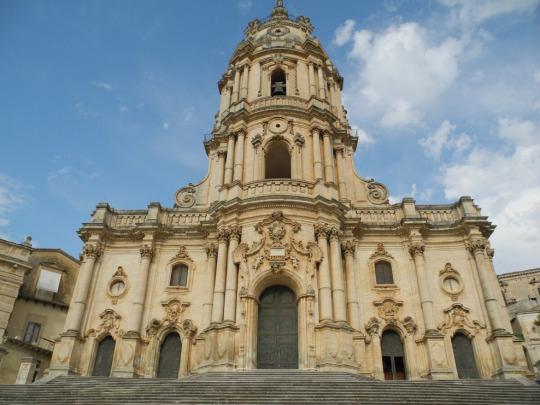










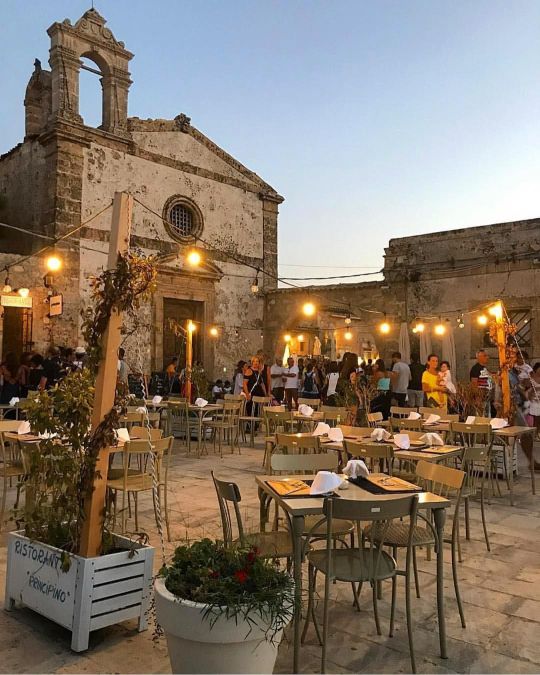
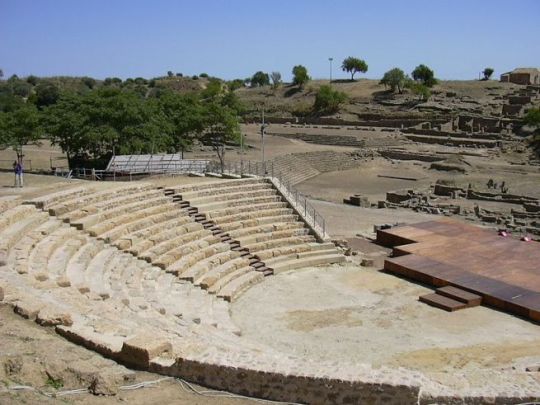


Sicilia - la mia isola. Alcune foto sono di Samueles
La mia terra è un’isola
e mi è madre ed amante,
culla, talamo, banchetto e bara.
Nei suoi tratti tra luce ed ombra
io trovo i miei pregi e difetti,
perché ogni singola goccia
della mia anima mediterranea
da lei è nato, in lei vive
e se l’amo e l’odio
è perché, amandola troppo
la vorrei perfetta,
motivo del mio perfetto amore.
La mia terra invece
è anche tutti i suoi figli
loro la distruggono e la creano
come mantidi egoiste
ed api laboriose
dandole ora abbracci di sangue
ora estasi d’amore.
Ma nella mia terra resta
il mio unico e solo bene
il mio male cannibale
sua la lingua con cui il cuore mi parla
suo il cibo di cui è fatto il mio corpo
sue le favole che dipingono la vita
suoi i dolori che l’hanno forgiata,
e per quanto abbia viaggiato
e parli e intenda altre lingue
io resto un suo seme
un suo verso affidato al mondo.
Viaggiando e conoscendo
ora so che ognuno porta in se
questo prezioso amore assoluto
ognuno è le parole antiche
imparate dalla sua terra.
Ognuno di voi che mi ascoltate
ha querce immense negli occhi
o vive di monti, spiagge infinite
dove il vento della vita fa danzare
l’arida sabbia dell’egoismo
o fiori colorati della pietà.
Ognuno di voi vive intensamente
la propria unica madre terra
quella che vi fa dire e capire,
e soprattutto amare.
Perché la vostra terra
è la padrona dei vostri ricordi
è la misura di quel tempo
che lento vi consuma
lei è tutto quello che ha nutrito
ha reso unica l’anima vostra
finché un giorno capirete
che non esiste la mia o la vostra
amata terra madre
ma solo una madre,
che è tutta la terra.
My land is an island, and it is my mother and lover, cradle, bed, banquet and coffin.
In her features between light and shadow, I find my strengths and weaknesses, because every single drop of my Mediterranean soul was born from her, lives in her, and if I love her and hate her, it is because, loving her too much I would like it perfect, reason for my perfect love.
My land, on the other hand, is also all her children, they destroy it and create it like selfish mantises and hard-working bees, now giving it embraces of blood, now ecstasy of love.
But in my land my one and only good remains my cannibal evil, her is the language with which my heart speaks to me, her is the food my body is made of, her are the fairy tales that paint life, her are the pains that forged it, and however much I have traveled and speak and understand other languages, I remain one of her seeds, one of her verses entrusted to the world.
Traveling and knowing now I know that everyone carries within himself this precious absolute love, everyone is the ancient words, learned from his land.
Each of you who listen to me has immense oaks in his eyes,
or he lives on mountains, endless beaches where the wind of life makes you dance the dry sand of selfishness or colorful flowers of pity.
Each of you lives intensely, your only mother earth, the one that makes you speak and understand, and above all love.
Because your land is the owner of your memories, it is the measure of that time that slowly consumes you, it is all that it has nourished, it has made your soul unique, until one day you will understand, that mine or yours does not exist. your beloved mother earth, but only one mother, which is the whole earth.
37 notes
·
View notes
Text
Des concerts à Paris et autour
Février
20. Autobahn – Supersonic (gratuit)
20. L'Efondras + Dr(Dr)One – Olympic café
20. Maggot Heart + Reveal + Plomb + End of Mankind – Le Klub
21. Thalia Zedek + Damon & Naomi – Olympic café
22. Nina Harker + Docks – Olympic café
22. Regina Demina & Eggplant + Léon Septavaux : "Haters" – Palais de Tokyo
22. Illnurse b2b Panzer – Nouveau Casino
23. Lee Ranaldo + Santiago + Mnnqns – La Maroquinerie
23. TG Gondard + Piyojo + Golden Q – Olympic café
23. Tout Est Beau + Zlùr + CD-DR + Lëster + La Venganza & Claravite + Nana Benamer – Le Klub
23. Chloé – A la folie ||COMPLET||
23. Dopplereffekt + La Corde + Marion Guillet – La Java
23. Shifted + SNTS + Nozen – Nuits fauves
23. Mondkopf + Maoupa Mazzocchetti + December + Garçon manqué + Martijn Verrycken – La Station
23. Katran + Gijensu – Glazart
23. Ayarcana + Joefarr + Jarod + Roswell + Sagarto – tba
24. Tout Est Beau – Silencio (gratuit sur résa)
24. Omar Souleyman – Yoyo|Palais de Tokyo
24. HBT + Coldgeist – Centre Barbara-FGO
24. αίών & Schreib (dj) + Acesence + Méryll Ampe + Fubar + NO3sis (fest. Les Sonifères) – DOC
24. Charles LTM + Marai + Harshlove + Bajram Bili – La Rotonde
24. Domotic + Bisou de Sadam – Treize
24. The Dead Mantra + Blue Mountain Expansion + Theda – Petit Bain
24. Broken English Club + Bjarki + Dr Rubinstein + HBT + YSC – Concrete
25. Ville nouvelle (dj) + Elen Huynh + Adrien Kanter + :such: + Bob Cooper (fest. Les Sonifères) – DOC
25. Mundopal + Laurent Ho + Hanah + Largo + Mara Lakour + Sébastopol + Aubry + Lucien & The Kimono Orchestra – La Station
25. The Sonics + The Ready-Mades – La Maroquinerie ||COMPLET||
25. The Monochrome Set + Jaromil Sabor – Supersonic
27. The Charlatans – La Maroquinerie
Mars
01. Years of Denial + Areva + Vulcanizadora – L'International (gratuit)
01. The Pains of Being Pure at Heart – Petit Bain
01. Regina Demina & Eggplant + Léon Septavaux : "Haters" – Palais de Tokyo
01. Alessandro Bosetti + Lionel Marchetti – Instants chavirés (Montreuil)
02. Klimperei & Madame Patate + David Fenech & Denis Frajerman – Chair de poule (gratuit)
02. Aquaserge + Orval Carlos Sibelius + La Mirastella – Petit Bain
02. Vale Poher + Titus d'Enfer – Centre Pompidou
02. Princess Nokia – Fondation Vuitton
02. La Muse en circuit joue "Fondu au noir" de Pierre Henry – Conservatoire national supérieur d'art dramatique
02. Sister Iodine + CIA débutante + Kill TM (Unglee Izi, Zofie Taueber, Romain Perrot, Kasper Toeplitz, Gaël Angelis & Andy Bolus) – Instants chavirés (Montreuil)
02. Aymeric de Tapol + Tourette + Leila Bordreuil & Zack Rowden+ Tucuxi + MMY + None & Detemple + Mitua + Käpäk + Graal – Carbone 17 (Aubervilliers)
02. Clouds + Herrmann + Lewis Fautzi + De Vedelly – Rex Club
03. Magnetix + Male Gaze – Espace B
03. Akiko Nakayama + Ei Wada + Lite + Tomoko Sauvage + Lei Sato (Biennale Nemo) – Le 104
03. Dan Deacon – Fondation Vuitton
03. Sister Iodine + Jean-Philippe Gross & Jérôme Noetinger + Hit & Run (Valérie Smith & Clatk Gable) + Jean-Marc Foussat – Instants chavirés (Montreuil)
05. IAMX – La Machine
07. Les Troupes de l'imaginaire (fest. Sonic Protest) – Médiathèque musicale (gratuit)
07. Franck Vigroux & Antoine Schmitt : "Chronostasis" + Alexander Schubert : "Codec Error" – Centre Pompidou
07/08. Ryuchi Sakamoto & Shiro Takatani (Dumb Type) : "Dis.Play" – Maison de la Culture du Japon
08. Cheval scintillantes + Delphine Dora – Le Zorba (gratuit)
08. Molecule – Elysée Montmartre
08. Regina Demina & Eggplant + Léon Septavaux : "Haters" – Palais de Tokyo
08. Trevos Wishart + Davide Tidoni (fest. Sonic Protest) – Théâtre de Vanves
08. Léonie Pernet – O Gib (Montreuil)
09. Bretzel Göring + Kollektiv Barner 16 + Mohamed Lamouri (fest. Sonic Protest) – Centre Barbara-FGO
09. Elliott Murphy – Mona Bismarck American Center
09. Adam X + Perc + Pulse One + Parfait – tba
10. Wild Classical Music Ensemble + Dolly Rambo + DNA,AND feat. Ogrob (fest. Sonic Protest) – Centre Barbara-FGO
10. ARP TARK (Aymeric Hainaux) – Centre national de la Danse (Pantin) (gratuit)
10. Julien Desprez – Centre national de la Danse (Pantin)
10. Deena Abdelwahed (dj) + Sundae (dj) – Centre national de la Danse (Pantin) (gratuit sur résa)
10. Radioactive Man + AZF + Erika b2b Noncompliant + Powder – Concrete
13. Luminous Bodies – Espace B
14. Balmorhea + Martyn Heyne – Point FMR
14. Rodolphe Burger : cinéconcert sur "L'Inconnu" de Tod Browning – Cinémathèque
14. I Hate Model + Marc.Andrea + Sina – Rex Club
15. Arto Lindsay + Seijiro Murayama & Thomas Brinkmann + Masami Kawaguchi (fest. Sonic Protest) – Eglise Sant-Merry
15. Esmerine – Point FMR
15. C.A.R. – Badaboum
15. Regina Demina & Eggplant + Léon Septavaux : "Haters" – Palais de Tokyo
15. Maud Geffray & Lavinia Meijer jouent Philip Glass (fest. Paris Music) – Eglise Saint-Eustache ||COMPLET||
16. The Altered Hours – Supersonic (gratuit)
16. Morton Subotnick, Alec Empire & Lillevan + Kevin Drumm (fest. Sonic Protest) – Eglise Saint-Merry
16. Panico Panico + The Absolute Never + Thharm – Pointe Lafayette
16. Virginie Despentes & Zëro + Dream Wife + The Pack AD + La Pietà + Léonie Pernet (fest. Les femmes s'en mêlent) – La Machine
16. Minimal Syndicat + Illnurse + Murd + The DJ Producer – Glazart
16. Pär Grindvik + SHXCXCHCXSH +Nozen – Nuits fauves
17. Arnaud Rebotini + Etienne Jaumet (dj)... (fest. Paris Music) – L'Aérosol
17. Maher Shalal Hash Baz + Mick Harris aka Fret + Russell Haswell + ZB Aids + Paddy Steer + Thomas Tilly + Terrine + Satan (fest. Sonic Protest) – L'Echangeur (Bagnolet)
17. British Murder Boys + Lucy + Dasha Rush + Anetha – Terminal 7
19. Koban – Supersonic (gratuit)
19. Fever Ray – Olympia
20. Hackedepicciotto – Walrus (gratuit)
21. Hackedepicciotto + Phoenician Drive + Maninkari – Supersonic (gratuit)
21. Egopusher – Centre culturel suisse
22. Goran Bregovic & l'orchestre des mariages et des enterrements – Salle Pleyel
23. PurForm + TRDLX (Biennale Nemo) – Grande Halle de La Villette
23. Pierre Henry (diff.) + Anabelle Playe + John Chantler + Bill Orcutt + Anthony Child (Présences électronique) (Présences électronique) – Maison de la radio|Studio 104
23. Hey Colossus + Grey Hairs – Espace B
23. Delacave – Supersonic
23. Zombie Zombie – Le Plan (Ris-Orangis)
23. Paula Temple + Tommy Four Seven + Umfang – Nuits fauves
24. Alva Noto & Anne-James Chaton : Alphabet (Biennale Nemo) – Grande Halle de La Villette
24. Else Marie Pade + :such: + Bellows + Phonophani + The Caretaker (Présences électronique) – Maison de la radio|Studio 104
24. Youth Code + Carpenter Brut – Olympia
24. Jessica93 + JC Satàn – La Clef (Saint-Germain-en-Laye)
25. Jacques Lejeune + Chris Corsano + Ben Vida & Marina Rosenfeld + Mads Emil Nielsen + Gravetemple (Présences électronique) – Maison de la radio|Studio 104
29. Chicaloyoh + KosmoSuna – Le Zorba (gratuit)
29. Bleib Modern – Supersonic (gratuit)
29. Drame + Le réveil des tropiques – Centre Barbara-FGO
29. Angry Skeletns + Laurence Wasser – Pointe Lafayette
30. Orval Carlos Sibelius + Domotic – Le Zorba (gratuit)
31. Schlaasss + Petosaure + Enfance de merde – Supersonic (gratuit)
31. Maulwürfe (fest. Artdanthé) – Théâtre de Vanves
31. The Noise Consort (fest. Artdanthé) – Théâtre de Vanves
Avril
04. Suuns – Elysée Montmartre
05. UUUU – Espace B
05. Dance with the Dead + Christine + Mlada Fronta + Confrontational + Midnight Danger – Gibus
06. Whispering Sons + The Guru Guru & Le Prince Harry – Supersonic
06. Le singe blanc + Nohaybanda! + Casse gueule – Cirque électrique
07. Terminal Cheesecake + GuiliGuiliGoulag + Sweet Williams + Futuroscope – Espace B
10. Jamie Stewart joue Xiu Xiu – Olympic café
10. Structure + Walking Idiots + Oktober Lieber – Le Klub
10. John Olson + Nate Young + Regression + Henry & Hazel Slaughter + Stare Case + Wolf Eyes + Evil Moisture – Instants chavirés (Montreuil)
11. JC Satàn – La Maroquinerie
12. The Ex + Anarchist Republic of Bzzz (fest. Banlieues bleues) – La Dynamo (Pantin)
13. DJ Krush – La Bellevilloise
13. Amusement Parks on Fire + Ulster Page + Misty Coast – Supersonic (gratuit)
14. Dominique a – Salle Pierre Boulez|Philharmonie
14. Badbad – tba (Montreuil)
14. Function + Shifted – La Machine
15. Dominique a – Cité de la musique|Philharmonie ||COMPLET||
18. Chrysta Bell – La Maroquinerie
19. Christian Death + Punish Yourself + Volker – La Machine
19. Peter Kernel – Point FMR
20. Idles – Trabendo
20. Die Selektion – Supersonic
21. Igorrr – Trabendo
21. Yan Wagner + Tristesse contemporaine (fest. Clap Your Hands) – Café de la danse
22. The Body + Fange – Olympic café
24>26. Franck Vigroux & Kurt d'Haeseleer – La Pop
26. Ought – La Maroquinerie
26. Wrekmeister Harmonies – Espace B
26. A Place To Bury Strangers – Trabendo
28. She Past Away + Lebanon Hanover + Selofan – La Machine
28. Arcade Fire – Bercy Arena
28. Rhys Chatham + Krikor Kouchian + Chloé & Vassilena Serafimova – Centre Pompidou
30. Koudlam + Bajram Bili + Pointe du lac – La Maroquinerie
30. Iron Fist of The Sun + Am Not + Kevlar + Kontinent – tba
Mai
07. Iceage – Petit Bain
10>12. Deerhoof + And Also the Trees + Tropic of Cancer + Ulrika Spacek + Derya Yildirim & Grup Simsek + First Hate + Good Morning + Stranded Horse + Better Person + En attendant Ana + Pantin plage + Magic Island + Buvette (dj) (Le Beau fest.) – Trabendo & La Petite Halle
19. Yo La Tengo – Cabaret sauvage
23/24. Otomo Yoshihide – Instants chavirés (Montreuil)
23>27. Marquis de Sade + Deerhunter + Flat Worms + Kate NV + Tzusing + Midnight Sister (Villette sonique) – tba
24. HMLTD + Faire (dj) – Petit Bain
29. The Damned – Petit Bain
30. John Maus (Villette sonique) – tba
30. Klimperei – tba
30. Igorrr + Ni – Les Cuizines (Chelles)
Juin
02/03. Björk + Beck + Jamie XX + King Krule + Father John Misty + Migos... (fest. We Love Green) – Bois de Vincennes
09. Trisomie 21 – La Maroquinerie
12. Damo Suzuki's Network – Espace B
14. Ty Segall & The Freedom Band – Bataclan
15/16. Ryoji Ikeda : "Formula - c4i - Datamatics" – Centre Pompidou
22. Modern Life Is War + Cro Mags – Petit Bain
25. Nine Inch Nails – Olympia ||COMPLET||
Juillet
06/07. Amelie Lens + Daniel Avery + Jeff Mills + Laurent Garnier + Kink + Richie Hawtin + Tale of Us + Solomun... (The Peacock Society) – tba
09. Eels – Olympia
Novembre
Michael Nyman : "War Work: 8 Songs with Film" – Salle Pleyel
en gras : les derniers ajouts / in bold: the last news
3 notes
·
View notes
Text
hey uhhh heres what i have of my essay so far. i just need help deciding if i should conclude this here or continue and add my comparison of lear to job
Shakespeare’s King Lear is a tragic play propelled by themes of betrayal, reconciliation, nothingness, justice, the importance of familial bonds, and the fragility of human relationships. Over the course of the play we bear witness to Lear’s quick descent into obsoletion, despair, and eventual madness due to the treachery of his unloyal daughters, set into motion by his own hurt pride, as Gloucester’s story of a similarly unrealized betrayal moves in tandem. As the plot progresses, the layers of treachery and betrayal grow and fold like a many-headed hydra, slowly consuming itself, with the only light to be found in the unwavering loyalty of characters like Kent and Cordelia. A tragedy is a tragedy, however, and no light is safe. Writers often work to challenge or uphold the ideas of their current society in their creations, and Shakespeare is far from an exception. Many of his works challenge the reach and will of God, as well as ideas of fate and predestination. Shakespeare weaves these challenges into King Lear through use of biblical allusions he later deconstructs, cushioned by Greek mythos that, while familiar, was not regarded as a central belief, if followed at all in this time, especially when compared to Christianity. In order to oppose these concepts, Shakespeare contrasts divine creation with the overarching theme of nothingness, paints Cordelia as a Christ-like figure, and draws parallels between Lear and the story of Job.
“Nothing” is a concept introduced early in the play that follows Lear throughout his trials. We hear of it first when Cordelia refuses to flatter her father with flowery words for a slice of his power. Lear, astonished by her refusal, insists, “Nothing will come of nothing: speak again” (online). Lear repeats this sentiment soon after in a conversation with the fool, who asks Lear “can [he] make no use of nothing” to which Lear replies, “Nothing can be made out of nothing” (online). While, in a literal sense, Lear is correct: it is physically impossible to conjure something out of nothing, and the fool is primarily referencing the state Lear has put himself in as he both lacks in land and power due to how he’s given everything to his wolvish daughters, this idea of nothingness easily translate to a more cosmic scale. Lear’s sentiments mimic a Latin phrase, “ex nihilo nihil fit” - “from nothing, nothing comes.” This idea falls in line with the philosophy of nihilism, the belief that life is meaningless and without absolutes or purpose, starkly contrasting with many Christian ideals, chiefly that all are given a reason to exist and work against the evils of the world. Most literally, this contrasts with the idea that God created all things from nothing. The inclusion of this seems worrisome and very nearly blasphemous, but this concept of nihilism ties into the despair that plagues the characters of King Lear. What point was there, outside of a narrative sense, for Gloucester to be disrespected and blinded in his own home because of his sons horrendous betrayal? What sense is there in Goneril orchestrating against her father and husband, killing her sister, and eventually herself? Gloucester himself remarks, “As flies to wanton boys, are we to the gods. They kill us for their sport” (online). Such seemingly inexplicable suffering could bring one to question God in such a way, particularly in the case of Cordelia. How could Cordelia’s death be justified as a factor of God’s plan when she is truly the only force of good in the entire play? More importantly, however, is the question as to why Shakespeare himself would write this. It’s doubtful his intention was to scorn or curse God and the suffering He allows, but instead to comment on humanity’s refusal to take hold of their lives and make their own course. Divine intervention is not present in King Lear but there is a lack of accountability and self-reflection in many of the characters, and though the Christian God is never referred to, questions and blame are raised to Greek gods throughout the play.
While no gods have a hold on the happenings of King Lear, one character in particular acts distinctly as a type of surrogate for a divine force. Cordelia herself is made to be a Christ-like figure in King Lear. She personifies truth, goodness, and forgiveness. Despite oweing her father nothing after he chose to banish her and take the faulty words of Goneril and Regan as truth, she worries for his wellbeing and, in her continuing loyalty, uses her power in an attempt to restore order once more in his favor.. During their reunion after her banishment, Lear kneels before her, begging for forgiveness while fully recognizing he is undeserving, but she nonetheless pardons him and expresses her love and respect for him even in his pitiful state (online). Despite her role as a wholesome beacon of good and her achievement of reconciling with her father, Cordelia still dies and with her death any semblance of hope left in the play withers away. This is where Cordelia contrasts with other Christ figures in literature. Jesus’s death had some positive significance in that he died for our sins, but Cordelia’s death brings no positive changes or movements in the workings of the play. Sick with grief and likely exhaustion, Lear dies cradling his daughter’s body in a manner reminiscent of the Pietà, and with his lord’s death, Kent vows to end his own life (online). Shakespeare’s decision to snuff out the only source of light in this tragic darkness ties back to the idea of nihilism; that nothing is sacred, good will not overcome evil because it simply does not matter.
#this is some steaming hot garbage btw be prepared#i should probably add more to my paragraph about cordelia but eh..#my citations are weird i know pay no attention to them pls
2 notes
·
View notes
Text
Inspired by Literature: The Neapolitan Collection
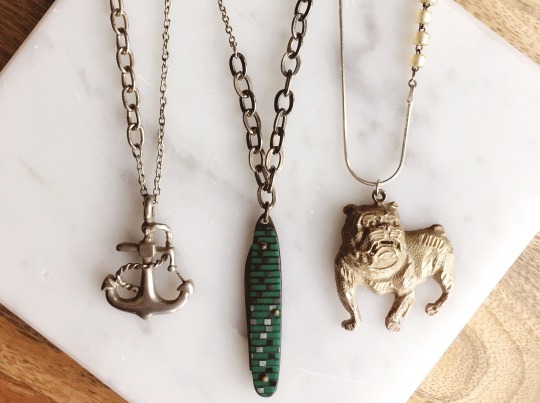
Those who know me well — or follow me on Instagram — know that I love the following three things: jewelry, rescue dogs, and reading! Literature has always been such an important part of my life and personal growth, so it only seemed natural to pull inspiration from my favorite readings into my designs.
The hidden stories of each vintage find I source from around the world really drives my creative passion for jewelry making. So, it was important for me to find a way to translate the meaning of these pieces into something more discernible — talismans inspired by powerful stories. And after last month’s gift guide for the Invention of Wings Collection, I was excited by the idea of starting a quarterly blog series to share these stories with you!
For my newest collection, I was influenced by the fiery feminism of The Neapolitan Novels by Elena Ferrante. This four-part series spans from the 1950s to present day and explores the ideas of being a woman from two different perspectives, both of whom grew up in a very oppressive culture. Ferrante tasks her readers with questioning whether it possible to rise above these gender biases and cultural norms. In my opinion, Ferrante was able to put into words the inner heart’s experiences in a way that brings a lifetime of truths to light. Her ability to be raw and brutally honest through her storytelling perfectly conveys the complexity and contradictions of human emotion.
After finishing the series, I knew I wanted to put together something that represented the grit and emotional contradictions present throughout each of the four books. Naples, the cultural backdrop of each novel, was depicted as dirty, poor, and corrupt — a city steeped in history with flashes of wealth that the characters can never seem to attain. So, likewise, this collection is made from antique and historical Italian pieces, some tarnished with the stories they’ve lived over the years. There are also a few pieces representing the elusive and coveted status of wealth.
Here’s a little more on the symbolism behind each design (I promise, there are no spoilers):
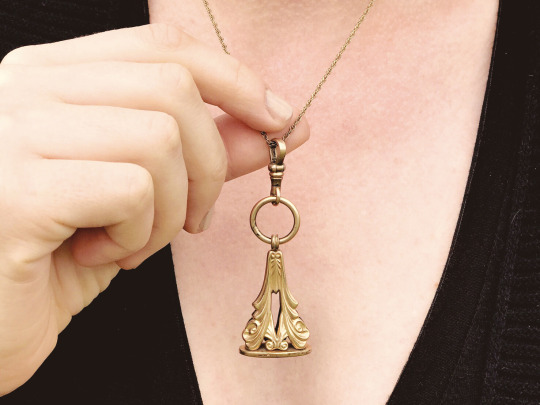
Antique Italian Maria Pendant Necklace
This vintage Italian pendant of the Virgin Mary, dated 1830, is inscribed with a prayer that loosely translates to “O Maria conceived without sin pray for us who have recourse to you.” I’ve become fascinated with the female form of the divine recently, which is almost completely non-existent in modern Christianity. And although Catholics don’t technically consider Mary divine, she does represent that for many people. Since feminism is tightly woven in the fabric of Elena’s novels, particularly the male “invention” of women, I wanted this piece to symbolize the existence of a God in female form, as an antidote to the misogyny of the patriarchal culture of 20th century Naples.
Antique Sterling Bulldog Necklace
The bulldog pendant, found while antiquing in Philly, has an aggressive quality to it that reminded me of the overarching theme of having to “overcome” being female. Ferrante writes in her novel Those Who Leave and Those Who Stay, “And no one knew better than I did what it meant to make your own head masculine so that it would be accepted by the culture of men; I had done it, I was doing it.” This quote embodies Elena’s struggle to take on masculine characteristics in order to succeed in society. In contrast, the vintage Italian rosary beads are closely associated with the veneration of the Virgin Mary, representing the strong feminine form inside.
Dante's Giornata Necklace
I love this piece so much because it couldn’t ring more true to the time period of these novels. This vintage Italian brass pendant of the esteemed Italian poet, Dante, dates back 50-80 years and — having grown up in Naples during the 1950s — the characters in these novels would have most definitely been reading Dante in school. The symbolism behind this piece speaks to the power of education to change one’s status and destiny in life. In The Story of the Lost Child, Ferrante writes about Lina, “She felt humiliated at having always ascribed to a power to things that in the current hierarchies were insignificant: the alphabet, writing, books.” This internal conflict is addressed in the novels by juxtaposing Elena’s journey with Lina’s, who has made the more courageous choice to stay in Naples and face her demons head-on without much schooling.
Italian Cornicello Necklace
Cornicello translated into English means “little horn.” This object is considered by Italians to be an amulet against the evil eye, which is said to curse the forces of generation (nursing mothers, babies, etc.) The horn is often connected to the Virgin Mary, and so I thought it would be an interesting piece to pair with the underlying themes of misogyny, as both Elena and Lina lash out at the men in their surroundings in order to thrive. To me, this silver horn pendant symbolizes the violence necessary to protect the girls’ independence.
Saint Vincenza Gerosa + Bartolomea Capitanio Necklace
St. Vincenza Gerosa and St. Bartolomea Capitanio, depicted in this century-old Italian pendant, were both devout Catholics dedicated to serving and teaching the poor and orphaned. Since the power of education played a big role in the lives of Elena and Lina, this was a perfect piece for this collection. There was a recurring presence and influence of generous teachers in The Neapolitan Novels, and it is clear that the children from the poorer areas would not have received any encouragement otherwise. Amidst so much tragedy, with so much stacked against them, they believed in the power of education, even though all evidence for the usefulness of their efforts was to the contrary.
Victorian Gold Filled Watch Fob Necklace
This 18th century Victorian-era fob would have been connected to a pocket watch chain for stamping and sealing envelopes with wax. This pendant is gold-filled and crafted by a fine jeweler, which I felt best represented Elena’s struggle with whether to prioritize her wealth and status. Fashion was a way that Elena differentiated herself from the neighborhood. However, she documents her continued struggle with the shallow nature of things in Those Who Leave and Those Who Stay by saying, “I had fled, in fact. Only to discover, in the decades to come, that I had been wrong, that it was a chain with larger and larger links: the neighborhood was connected to the city, the city to Italy, Italy to Europe, Europe to the whole planet. And this is how I see it today: it’s not the neighborhood that’s sick, it’s not Naples, it’s the entire earth, it’s the universe, or universes. And shrewdness means hiding and hiding from oneself the true state of things.”
Vintage Anchor Pendant Necklace
“I feel like the knight in an ancient romance, wrapped in his shining armor, after performing a thousand astonishing feats throughout the world, he meets a ragged, starving herdsman, who, never leaving his pasture, subdues and controls horrible beasts with his bare hands, and with prodigious courage.” This passage from Elena in Those Who Leave and Those Who Stay, depicts how Elena feels about Lina — who stayed in her hometown and fought courageous battles. The anchor represents this rooted connection to their neighborhood in Naples. The pendant is from Italy and dates back to the mid-1900s. The mixed chains provides a grittier look to the design and is a composite of various vintage chains.
Vintage Emerald Pocket Knife Necklace
There is a key scene in the novels where a school-age Lina stands up to the neighborhood bullies, who later move up in the ranks to become the neighborhood crime bosses. As they were approaching her and Elena in an effort to assault them, Lina pulled a knife in self defense and scared them off. Lina recalls in Ferrante’s writing that she “decided that it was urgent to become as autonomous as possible.” In a very obvious translation, I depicted her strength to challenge the abuses of women with this vintage, emerald and black checkered Italian mid-century pocket knife.
Vintage La Pieta + Year of Jubilee Necklace
This necklace features an antique Italian metal pendant engraved with the Pietà on one side and a commemorative scene indicating the 1975 Year of Jubilee (year of mercy) on the other side. Pietà represents the Virgin Mary holding crucified Christ, which can be connected to these novels through its theme of women surviving to suffer on the behalf of men. In Ferrante’s The Story of a New Name, there is a passage describing this destiny. “They had been consumed by the bodies of husbands, fathers, brothers, whom they ultimately came to resemble, because of their labors or the arrival of old age, of illness. When did that transformation begin? With housework? With pregnancies? With beatings?” In contrast, the “Year of Jubilee” on opposing side of this pendant balances that harsh reality with its representation of hope and mercy.
Vintage Sterling Locket Necklace
This delicate vintage locket containing an original address card was found during a recent trip to Philadelphia, and it seemed like the perfect fit with Elena and Lina’s journey to rise above their environment and place of origin. In Lost Child, Elena is quoted saying to Lina that her moving back to Naples was “an experiment in re-composition. You’ve managed to have your whole life here, but not me: I feel I’m in pieces scattered all over.” Similarly to the Vintage Anchor Pendant, I wanted this piece to embody Elena’s internal conflict with her loyalty to her hometown of Naples.
Have you had a chance to read The Neapolitan Novels? I’d love to hear your thoughts on the series!
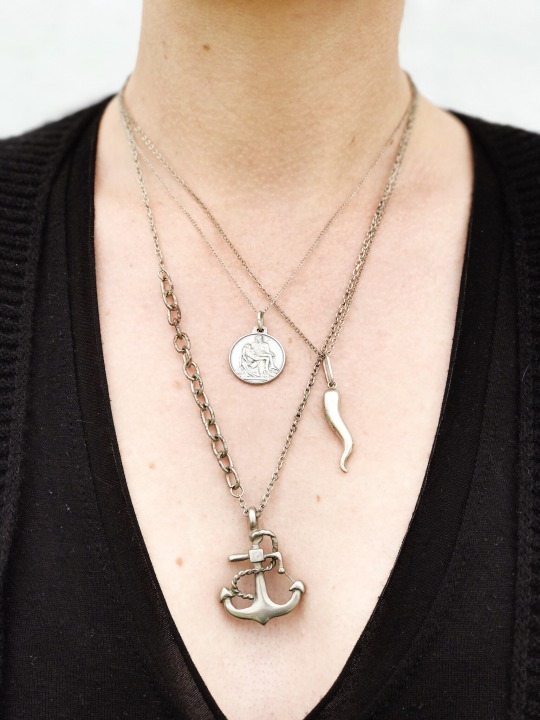
#vintage#vintage jewelry#literature#neapolitan#neapolitan novels#elena ferrante#inspiration#fine goods
0 notes
Photo
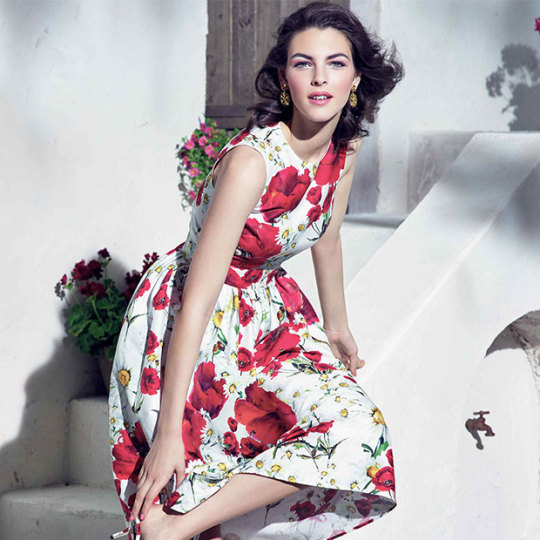

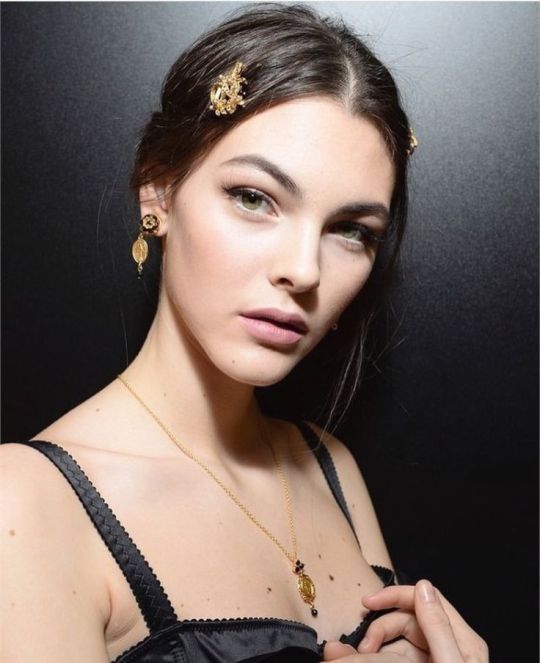



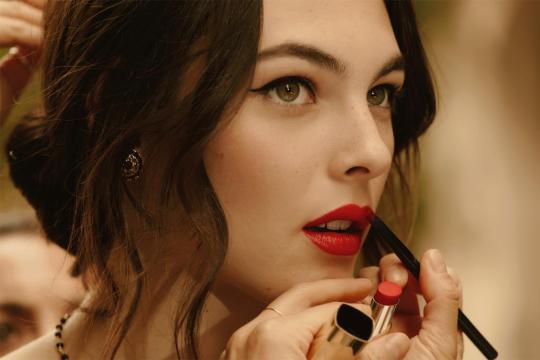



VITTORIA CERETTI mainly for D&G
FRAMMENTI INFINITI – CHE GUSTO HA
Che gusto ha il suo sorriso e di che colore è la luce dei suoi occhi? Che odore ha la sua voce e che sapore la sua pelle? Qual è il profumo di quando la sogni ed il velato retrogusto di quando ti abbraccia? Che luce hanno i suoi capelli sulla tua pelle, e che suono fanno le sue labbra quando la sfiorano? Qual è il colore della bontà e di che cosa sa la pietà? Forse di miele o di tuberosa, forse di sangue o di pane appena sfornato? Che profumo ha chi sorride ai malati, di chi stringe le mani a chi è accarezzato dalla morte, o di chi nella vita ha avuto solo addii? Qual è il suono di un sorriso e di che colore è il dolore di chi ha bisogno? Che profumo ha la paura, la fame, l’impotenza di fronte al male del mondo? Quanto pesa il silenzio in una corsia d’ospedale? di che note si vestono i ricordi di chi ci ha lasciato? Quanto è alta una primavera e quanto pesa lo sbocciare di un fiore? Come canta il seme quando germoglia e come piange un albero quando brucia? Come gridano le onde quando portano il corpo di chi le respirate ed i suoi occhi sono aperti a guardare l’azzurro di un cielo che non vedono? In che fiaba crede un bambino quando ha fame? Il tramonto ha un profumo di limone? E che gusto hanno i raggi della luna? Quale luce vede chi si impasticca in discoteca, o che canzone sente chi sta nascendo per strada? Le emozioni indossano sempre lo stesso vestito? Quanta fame ha l’indifferenza e come si trucca l’ignoranza? l’odio e l’egoismo hanno la barba? In tutti questi mille anni in cui la poesia mi ha cullato, ancora non ho imparato cosa sia, come funziona e dove nasce. La seguo incosciente e innamorato e lei ogni giorno, per la l’amore che ha per i poeti inutili, mi dona sempre qualcosa.
INFINITE FRAGMENTS - WHAT IT TASTE: What does your smile taste like and what color is the light in your eyes? What does her voice smell like and what does her skin taste like? What is the scent of when you dream of her and the veiled aftertaste of when she hugs you? What light does her hair have on your skin, and what sound do her lips when they touch it? What is the color of goodness and what does tast the pity has? Maybe honey or tuberose, maybe blood or freshly baked bread? What is the scent of those who smile at the sick, of those who shake hands with those who are caressed by death, or of those who only had farewell in their life? What is the sound of a smile and what color is the pain of those that need everything? What is the scent of fear, of the hunger, powerlessness in the face of the world's evil? How heavy is the silence in a hospital ward? What notes do the memories of those who already left us? How tall is a spring and how heavy is the blossoming of a flower? How does the seed sing when it sprouts and how does a tree cry when it burns? How do the waves scream when they carry the body of those who breathe them and her eyes are open to look at the blue of a sky they cannot see? What fairy tale does a child believe in when he is hungry? Does sunset have a lemon scent? And what does the moon's rays taste like? What light does someone who gets stuck in the disco see, or what song does someone who is being born in the street? Do emotions always wear the same dress? How hungry is indifference and how is ignorance put on? do hatred and selfishness have a beard? In all these thousand years in which poetry has rocked me, I still haven't learned what it is, how it works and where it is born. I follow her unconscious and in love and she always gives me something every day, for the love she has for useless poets.
20 notes
·
View notes
Photo










I RITI DELLA SETTIMANA SANTA IN SICILIA E IL COVID - Le confraternite di Enna, il Cristo Morto di Adrano, U’ncontru di Modica,
… sed libera nos a malo
Signuri, strogghi stu senzu i motti, vinci tu stu mali chi ni mancia, caccia stu dimoniu senza patruni, danni abbentu e sabbizza.
… sed libera nos a malo
Signuri, danni luci, danni sabbaziuni, caccia stu mali chi ni leva l’aria e n’affua senza nudda spiranza, vinci cu abbilena i to figghi e ogni nostru dumani
… sed libera nos a malo
Patretennu caccia sta motti chi n’aspetta nta ogni agnuni, mustrani a strada pi truvari paci, brucia stu demoni ranni quantu u nostru eguismu.
… sed libera nos a malo
scippa stu mali fotti quantu a nostra avidità, duru chiu di nostri cori i petra chi mazza a nui comi nui ammazzamu i frati
… sed libera nos a malo
liberani i stu focu vivu chi ni bampa i canni comu i nostri bummi brucianu carusi e matri, comi nui bruciamu foresti e mari
… sed libera nos a malo
Mustrani d’amuri chi nun avemu, da pietà chi non sapemu, da misericoddia chi nun canuscemu, du piddunu chi nun damu.
.. sed libera nos a malo
amen
… sed libera nos a malo
Sciogli questa sensazione di morte, vinci questo male che ci divora, caccia questo demonio senza padrone, dacci pace e salvezza
… sed libera nos a malo
dacci luce, dacci salvezza, caccia questo male che ruba l’aria e ci soffoca senza nessuna speranza, vinci chi avvelena i tuoi figli e ogni loro domani
… sed libera nos a malo
Padre Eterno, caccia questa morte che ci aspetta in ogni angolo, mostraci la strada per trovare la pace, brucia questo demone grande quanto il nostro egoismo
… sed libera nos a malo
strappaci questo male forte quanto la nostra avidità, duro più dei nostri cuori di pietra, che uccide noi così come noi uccidiamo i nostri fratelli
… sed libera nos a malo
liberaci da questo fuoco vivo che brucia le carni così come le nostre bombe bruciano bambini con le loro madri, come noi bruciamo foreste e mari
… sed libera nos a malo
Mostraci quell’amore che non abbiamo, quella pietà che non sappiamo, quella misericordia che non conosciamo, quell’amore che non diamo.
… sed libera nos a malo
... but deliver us from evil
Dissolve this feeling of death, overcome this evil that devours us, chase this demon without a master, give us peace and salvation
... but deliver us from evil
give us light, give us peace, drive out this evil that steals the air and suffocates us without any hope, win those who poison your children and every their tomorrow
... but deliver us from evil
Eternal Father, chase this death that awaits us in every corner, show us the way to find peace, burn this demon as big as our selfishness
... but deliver us from evil
tear us off this evil , it is as strong as our greed, harder than our hearts of stone, that kills us as we kill our brothers
... but deliver us from evil
deliver us from this living fire that burns our flesh just as our bombs burn children with their mothers, as we burn forests and sea
... but deliver us from evil
Show us that love that we do not have, that pity that we do not know, that mercy that we do not feel, that love that we do not give.
... but deliver us from evil
18 notes
·
View notes